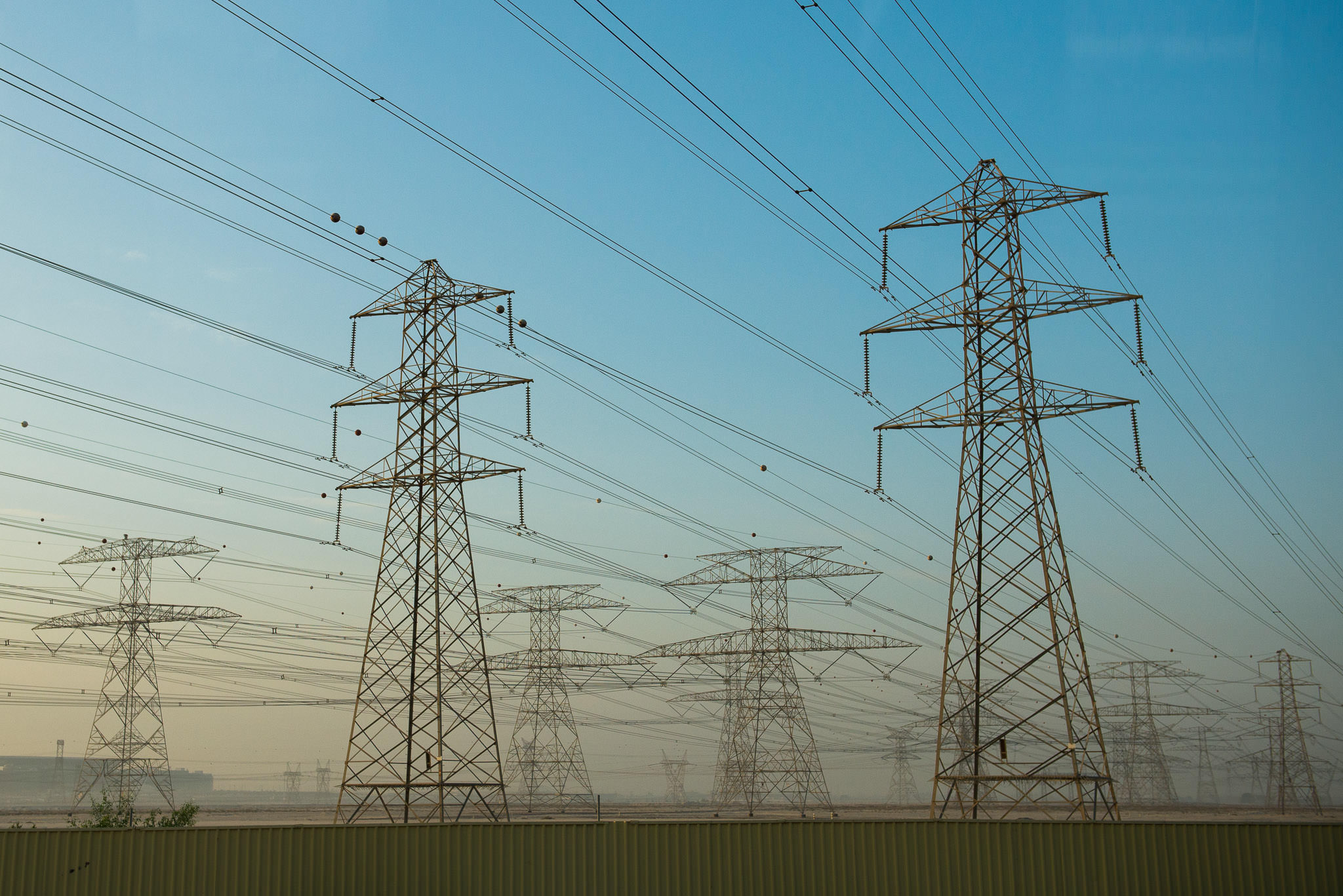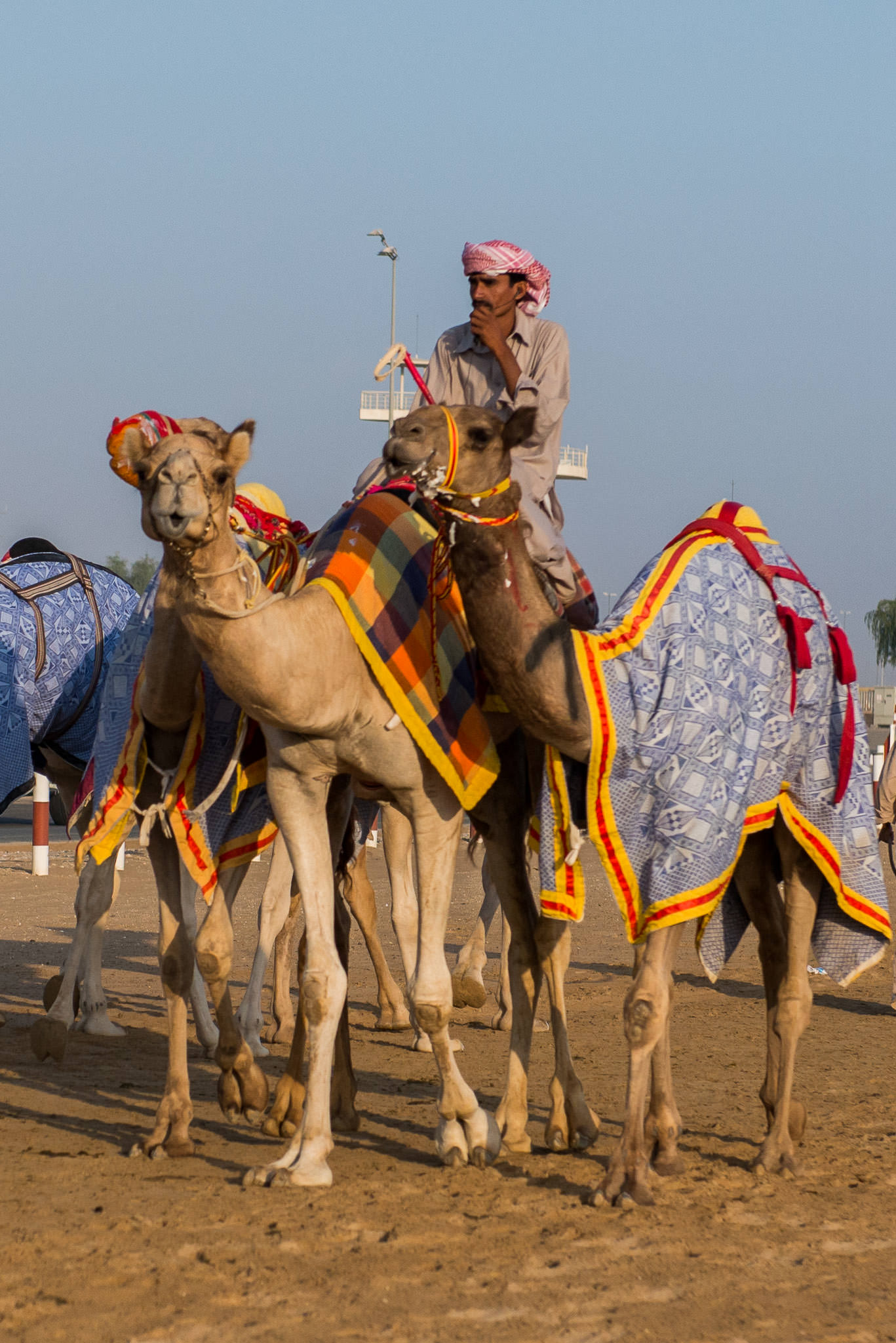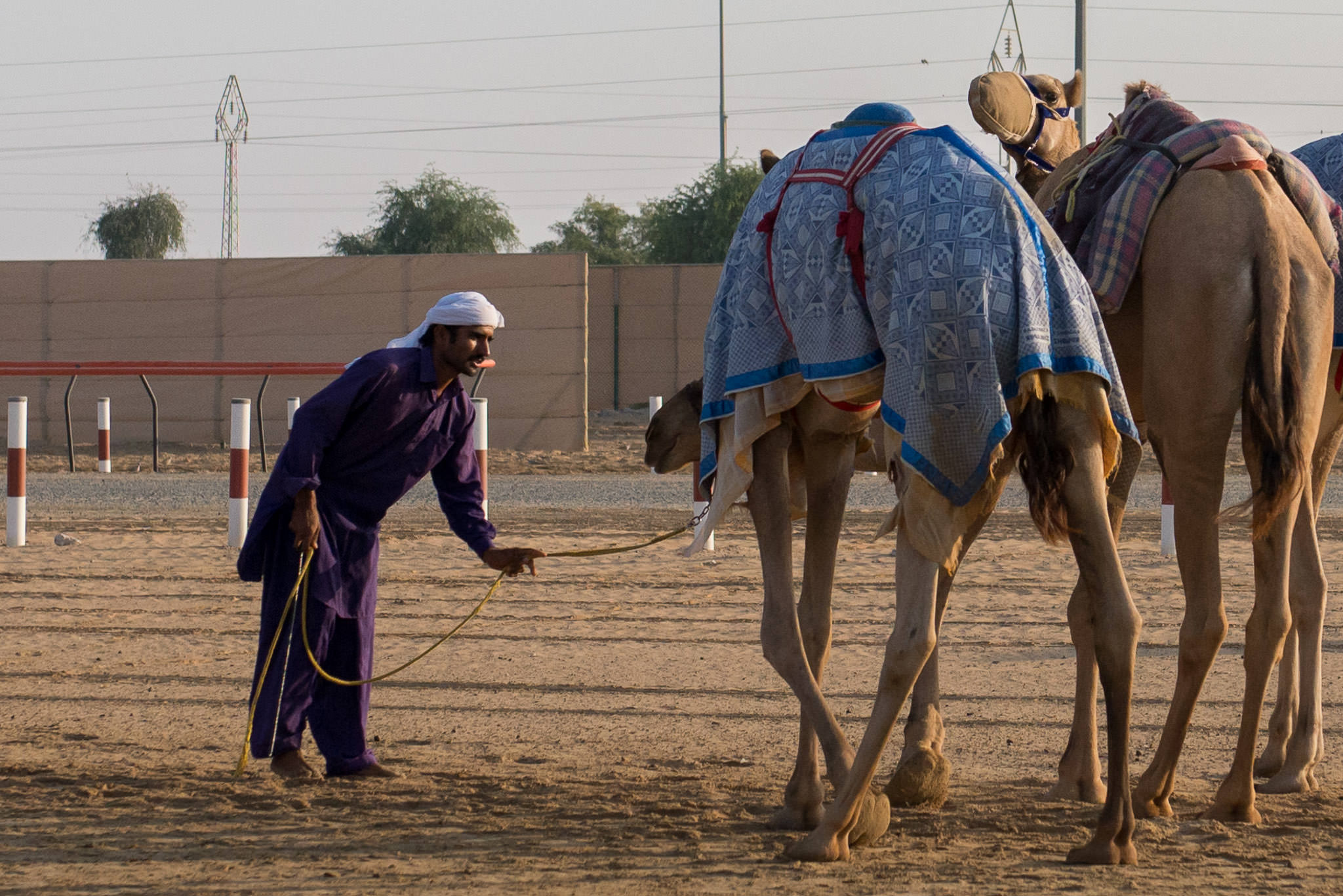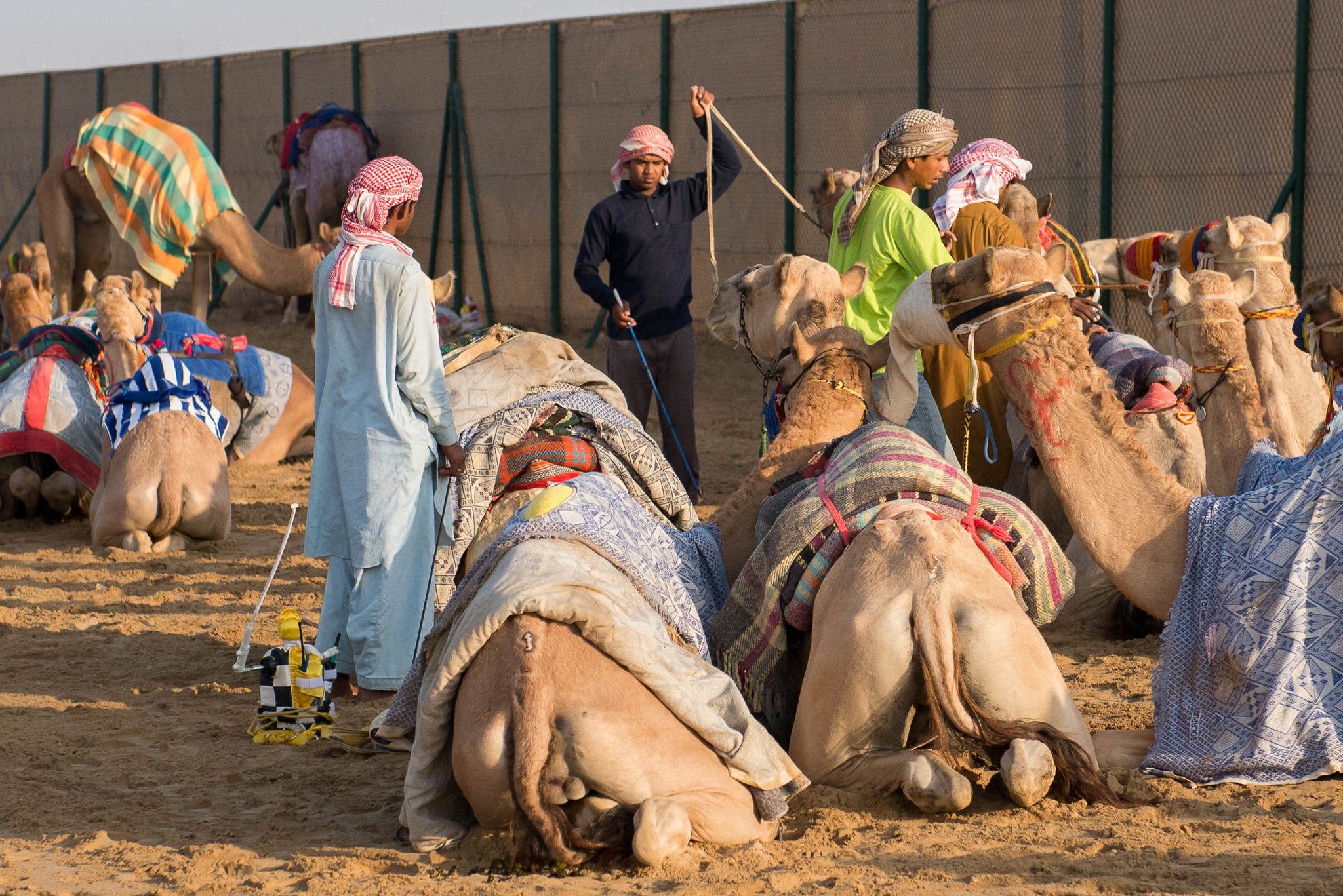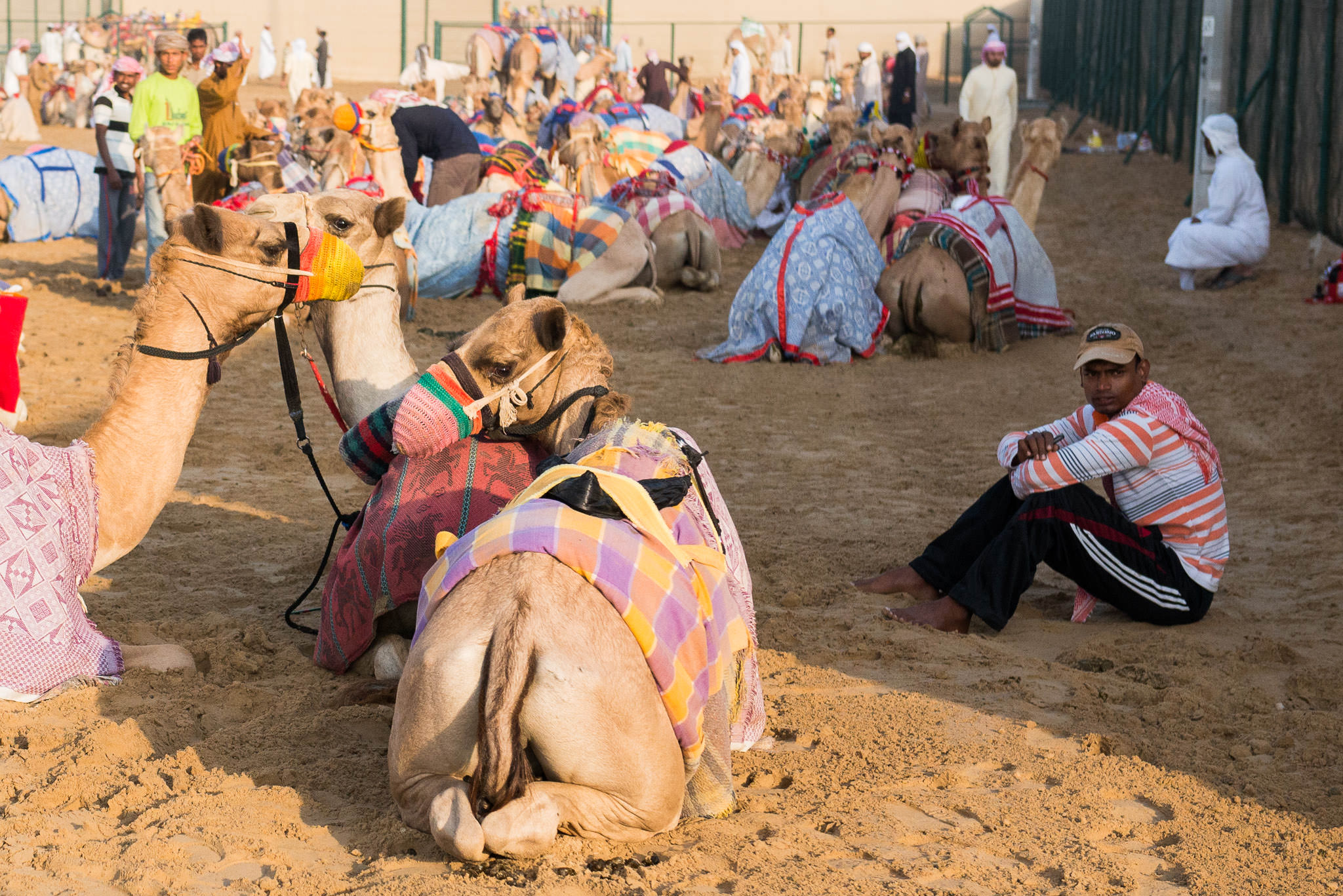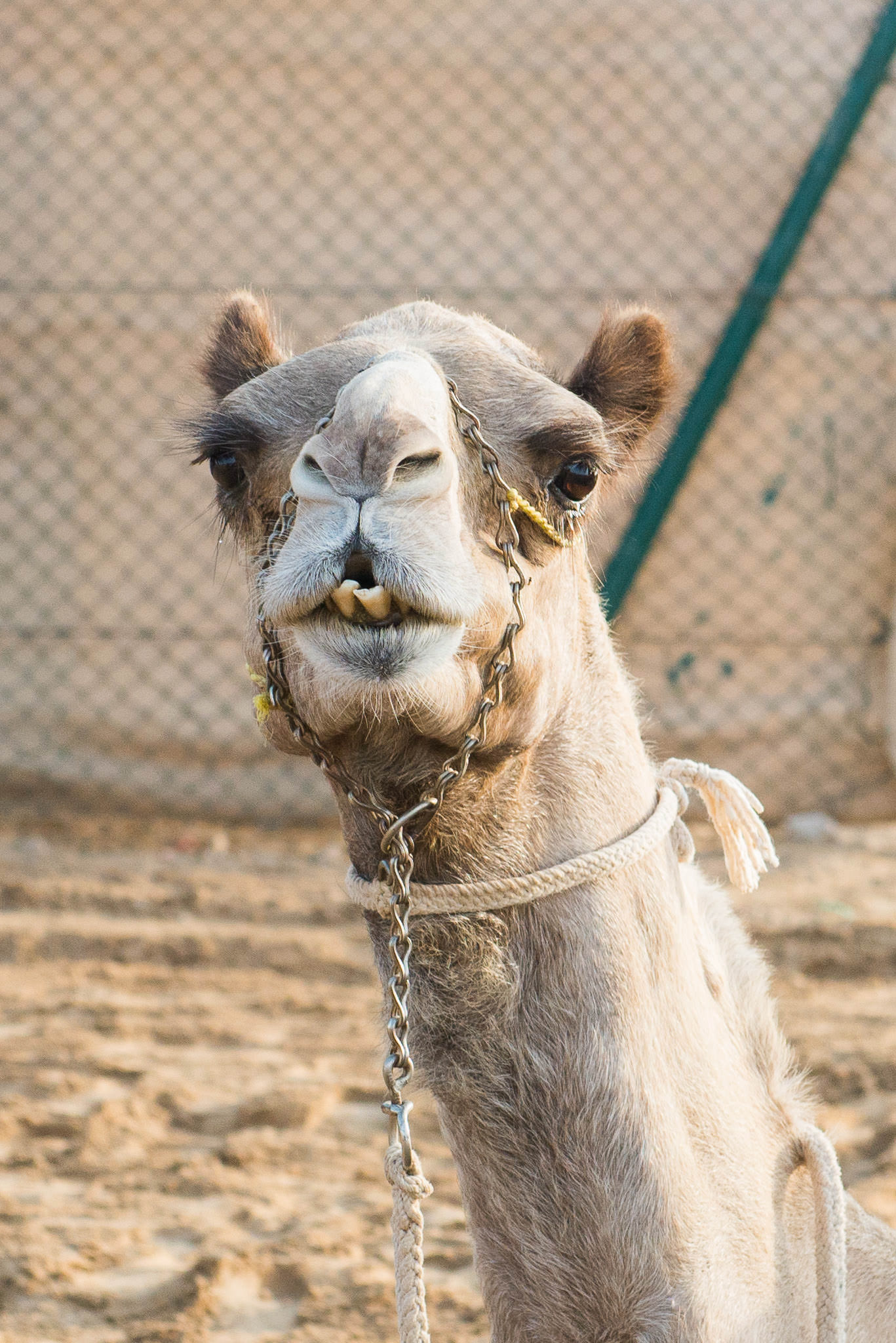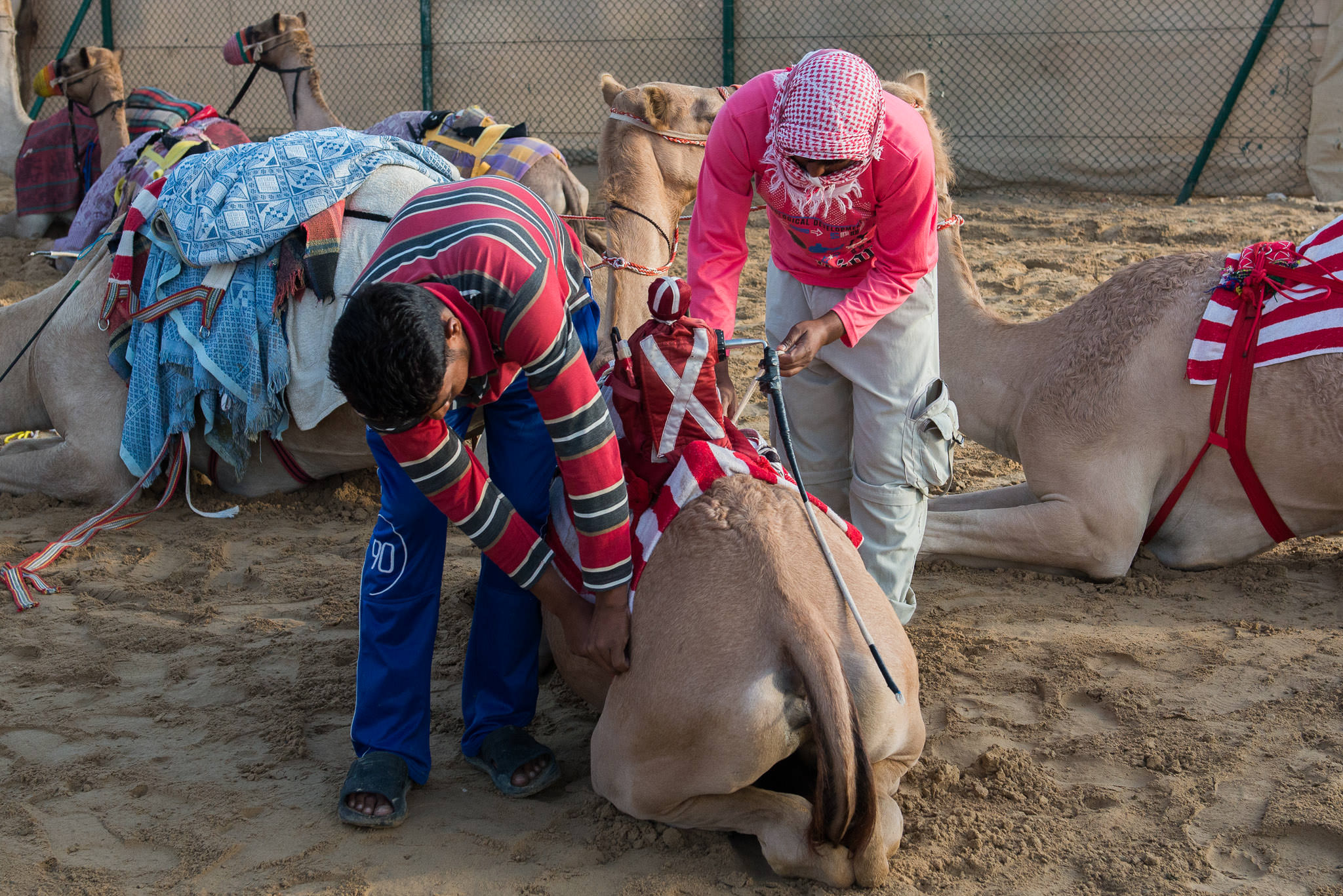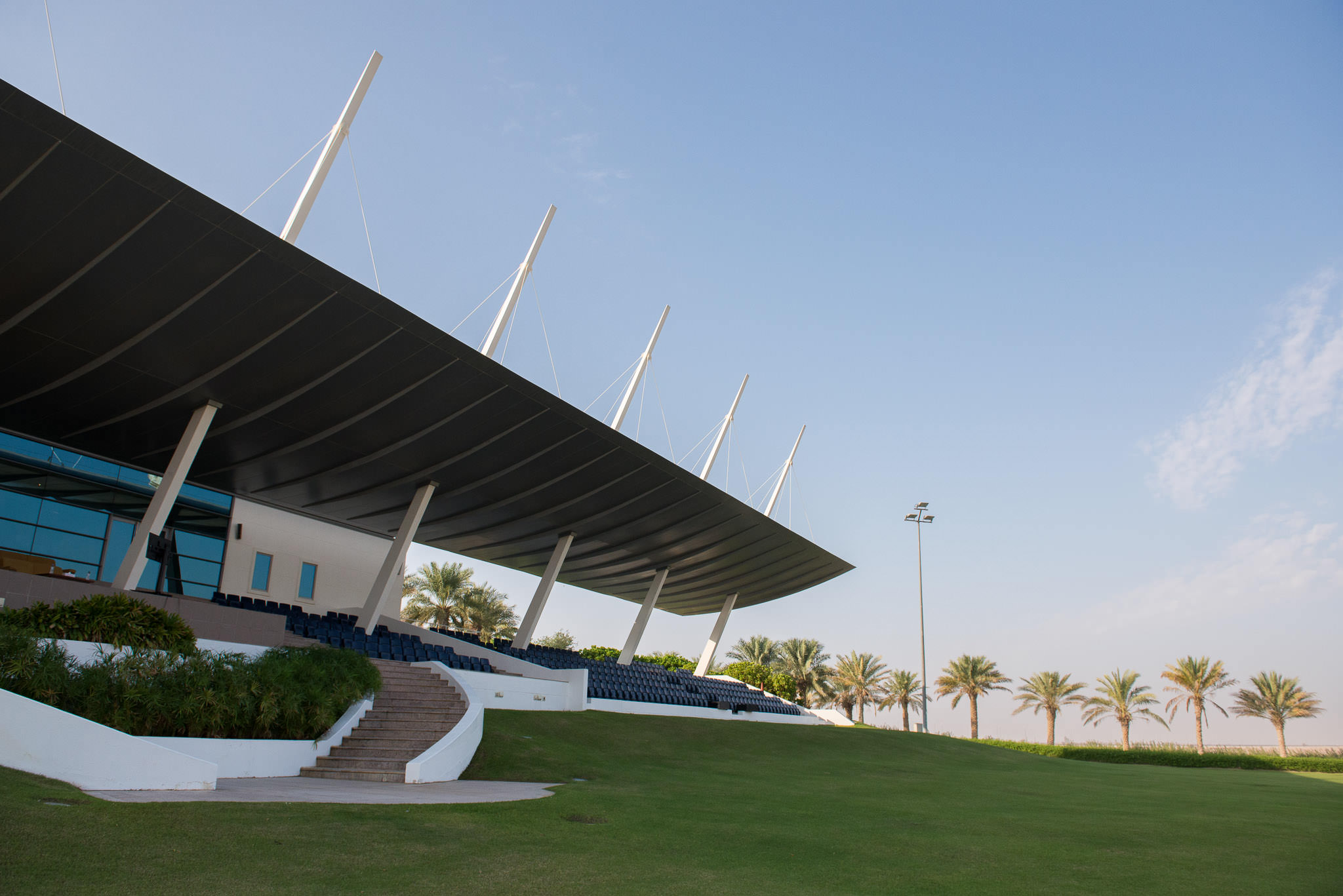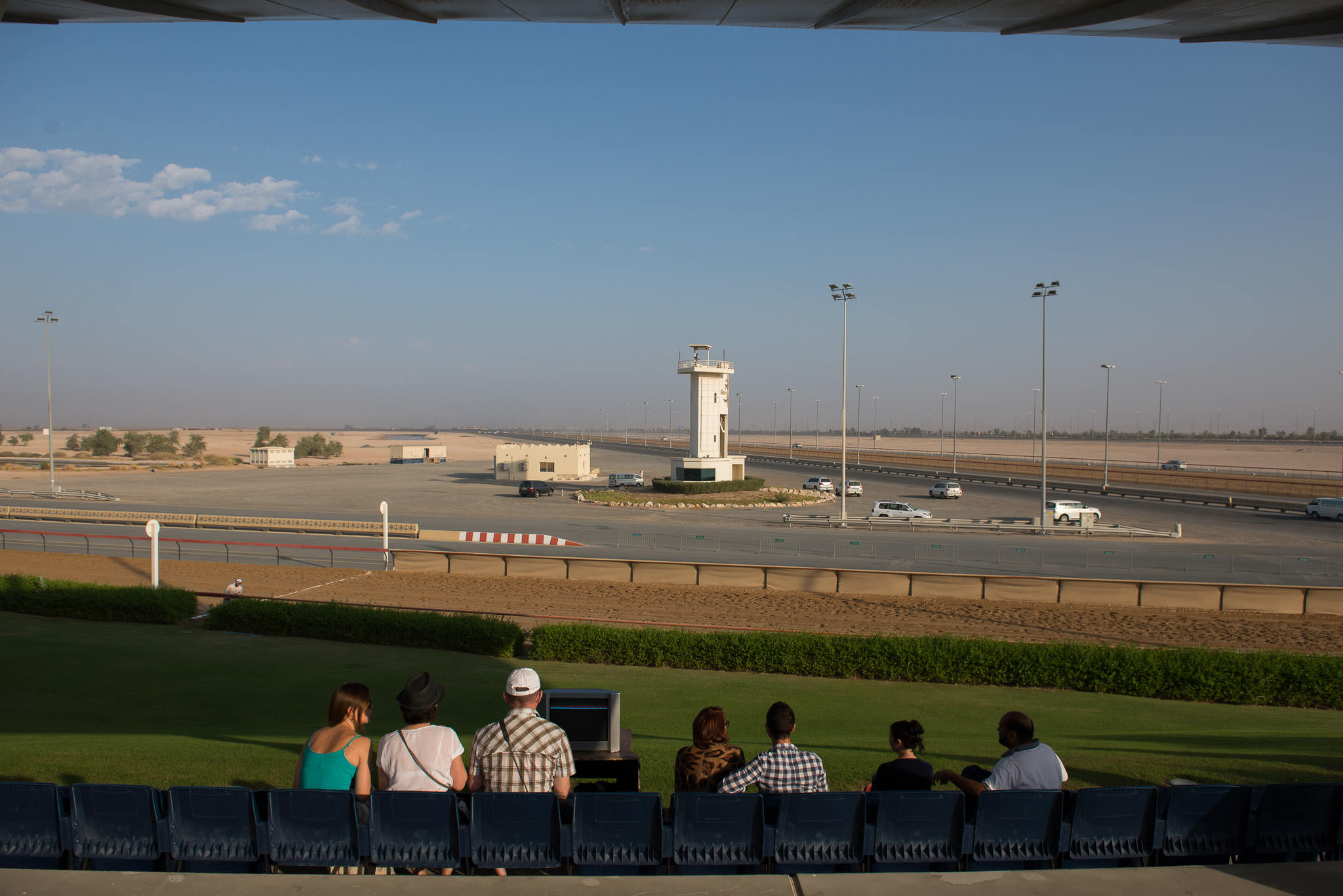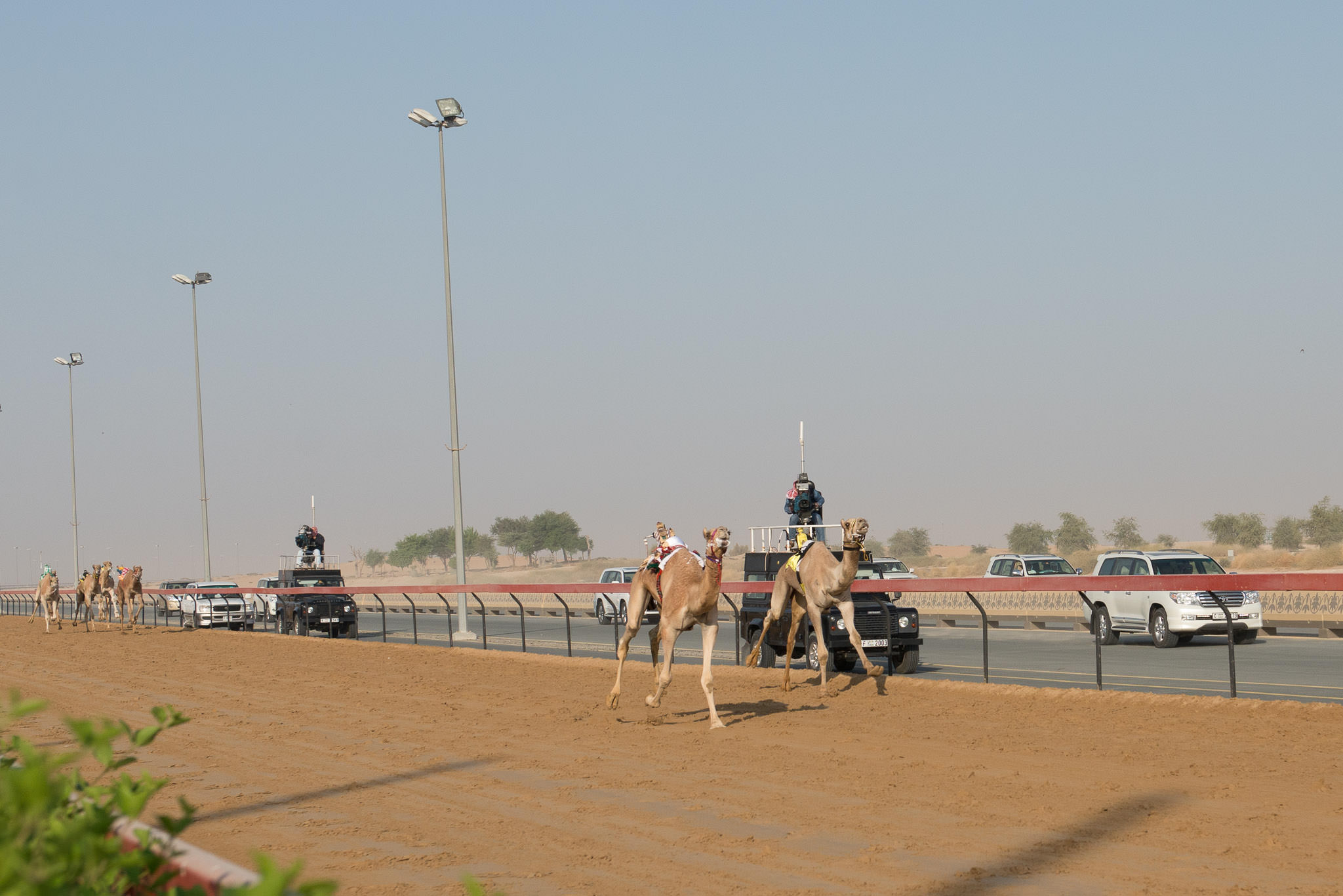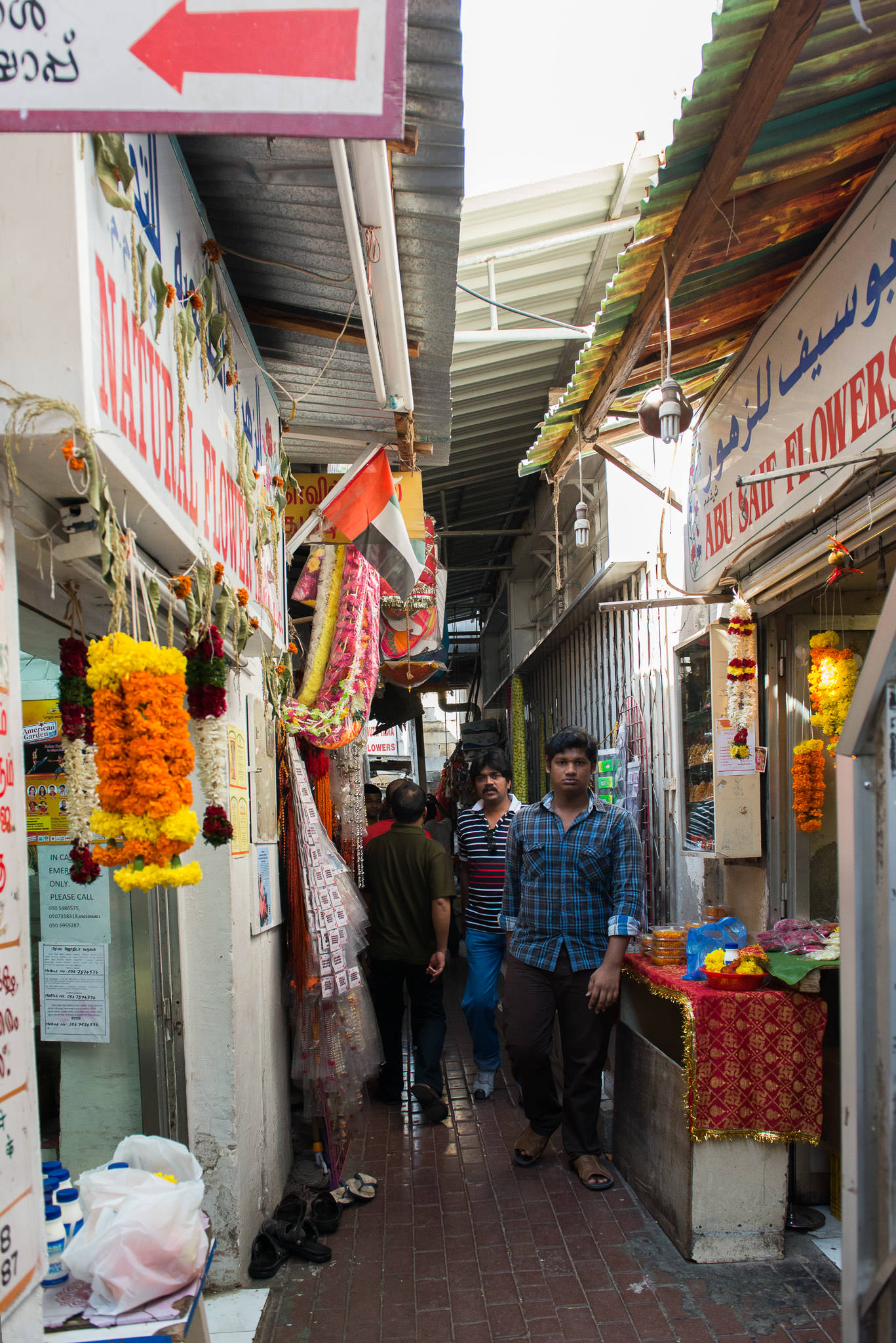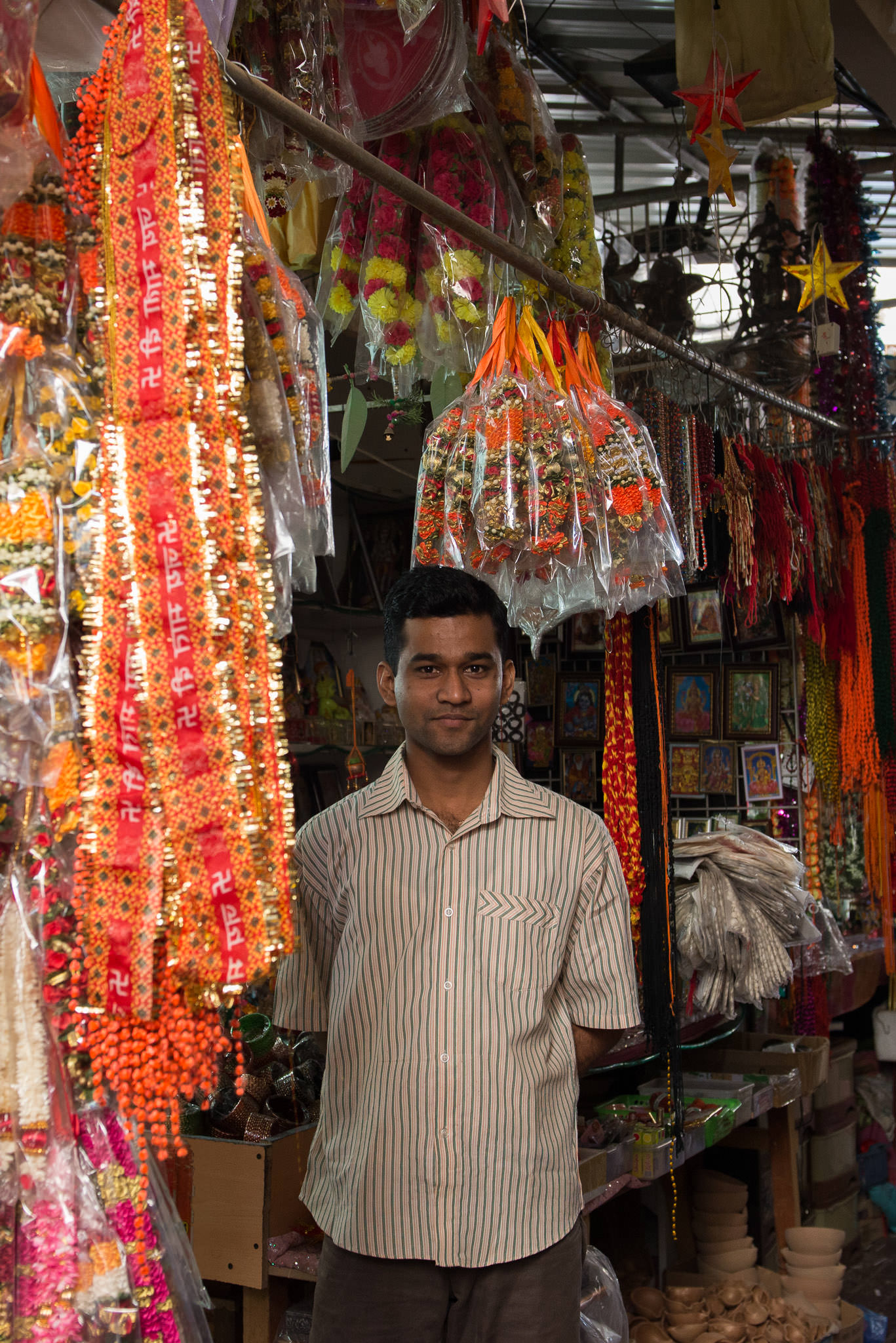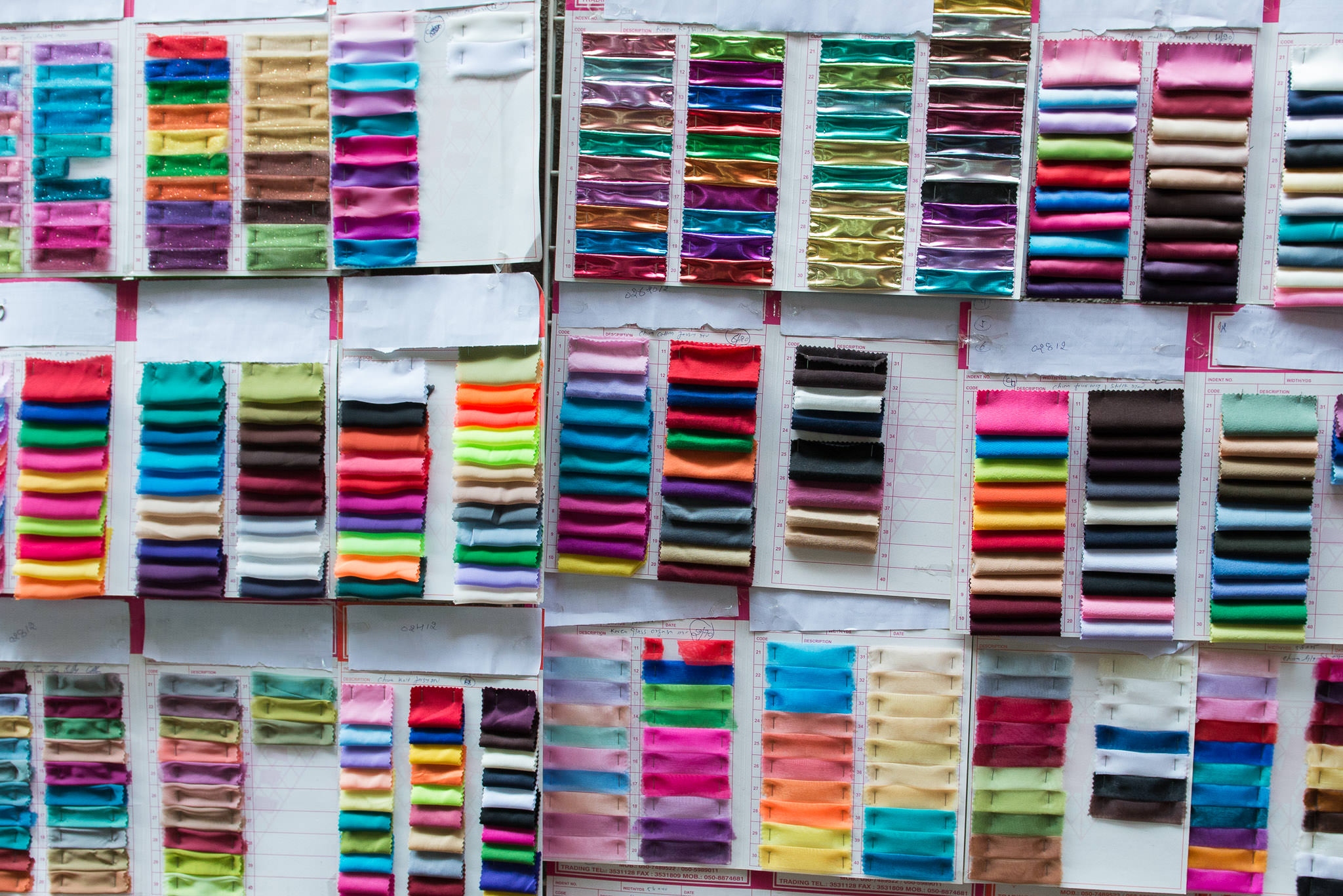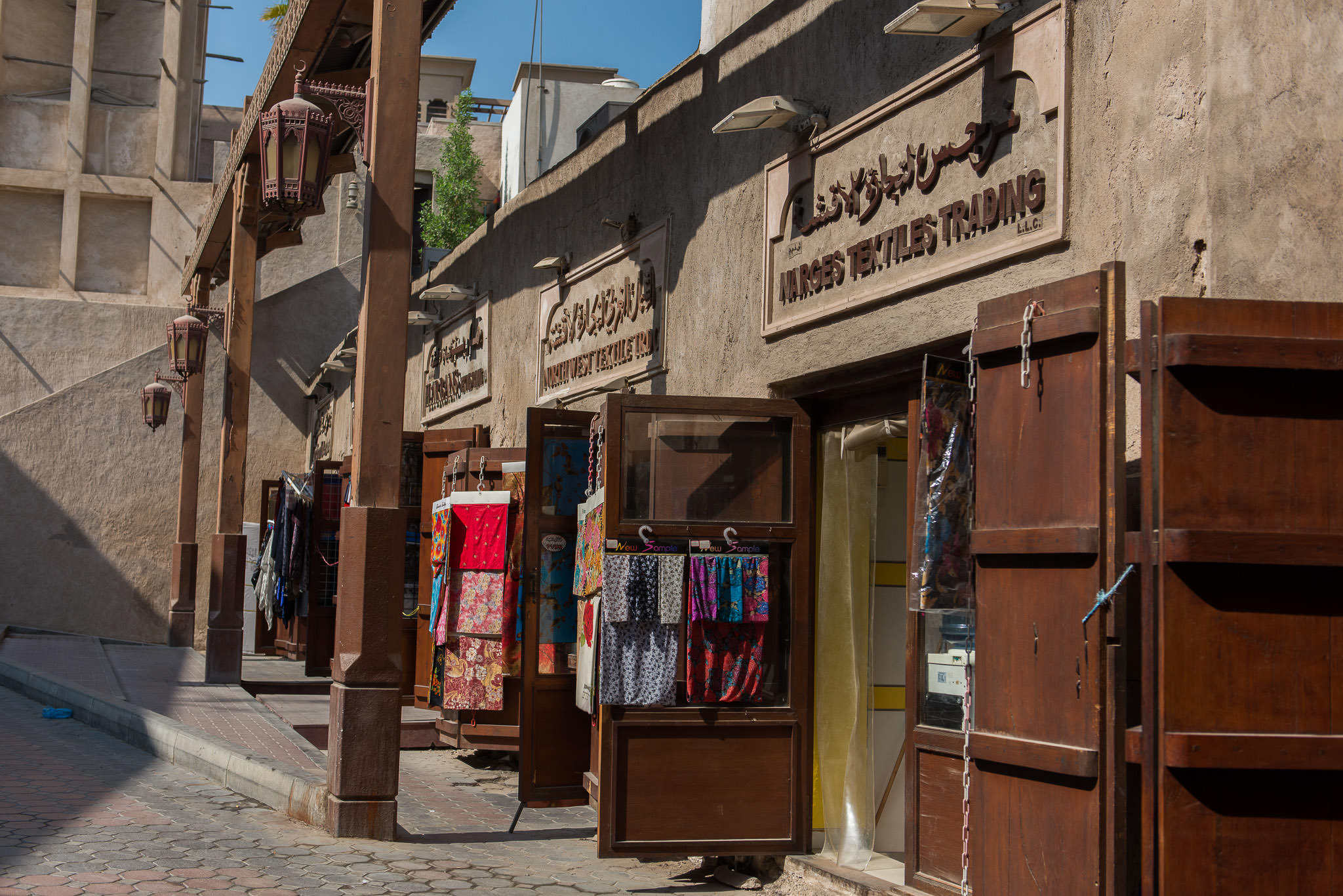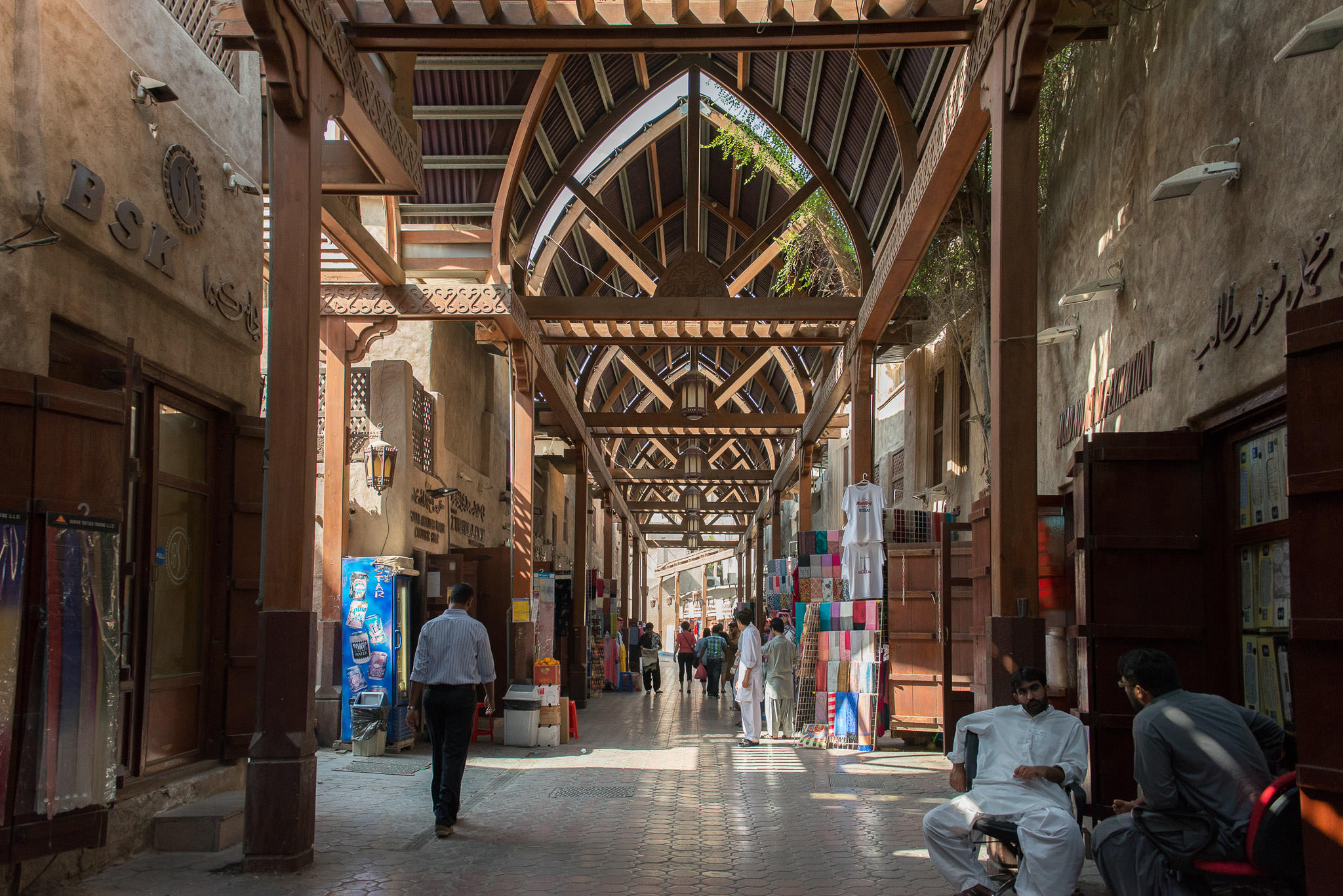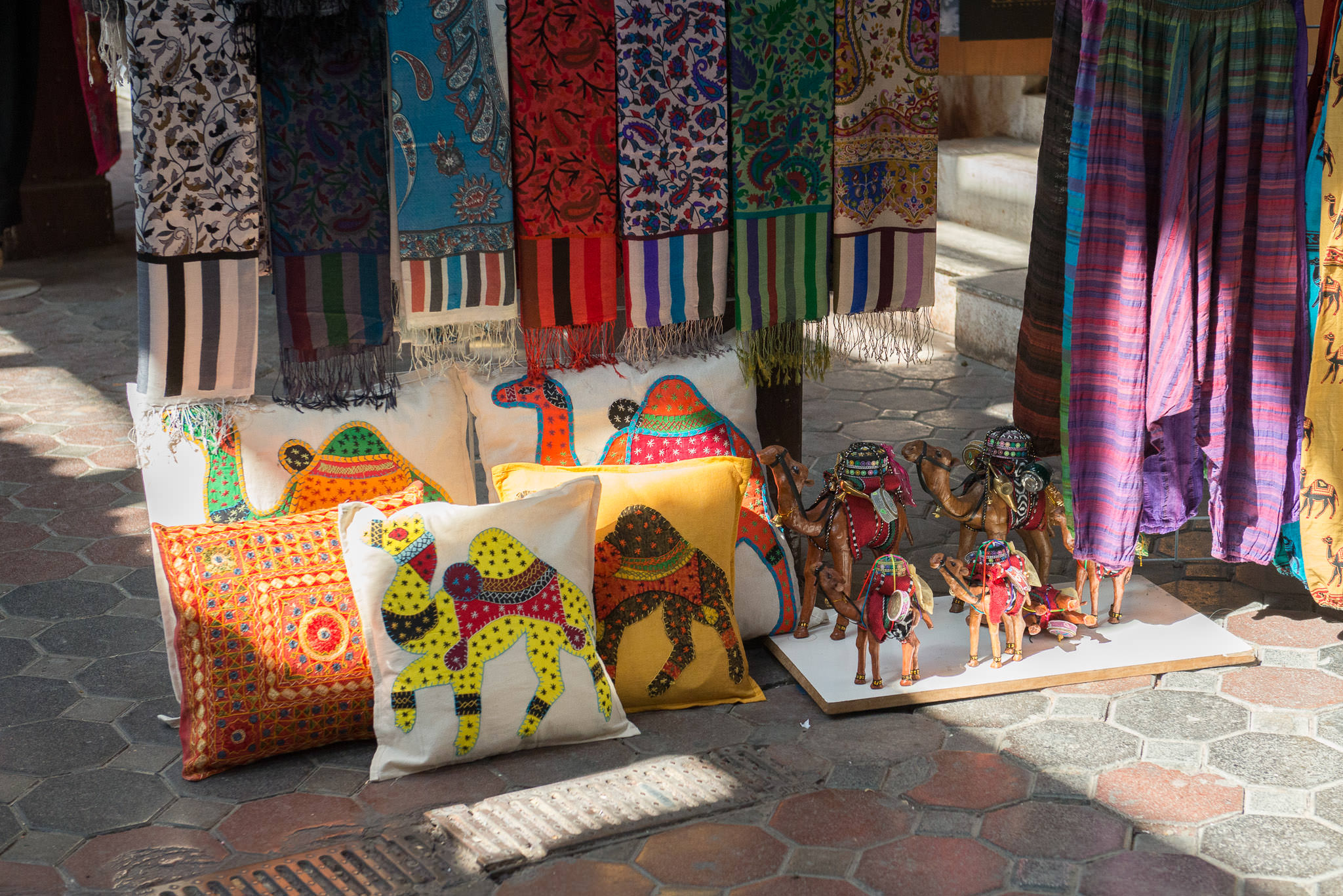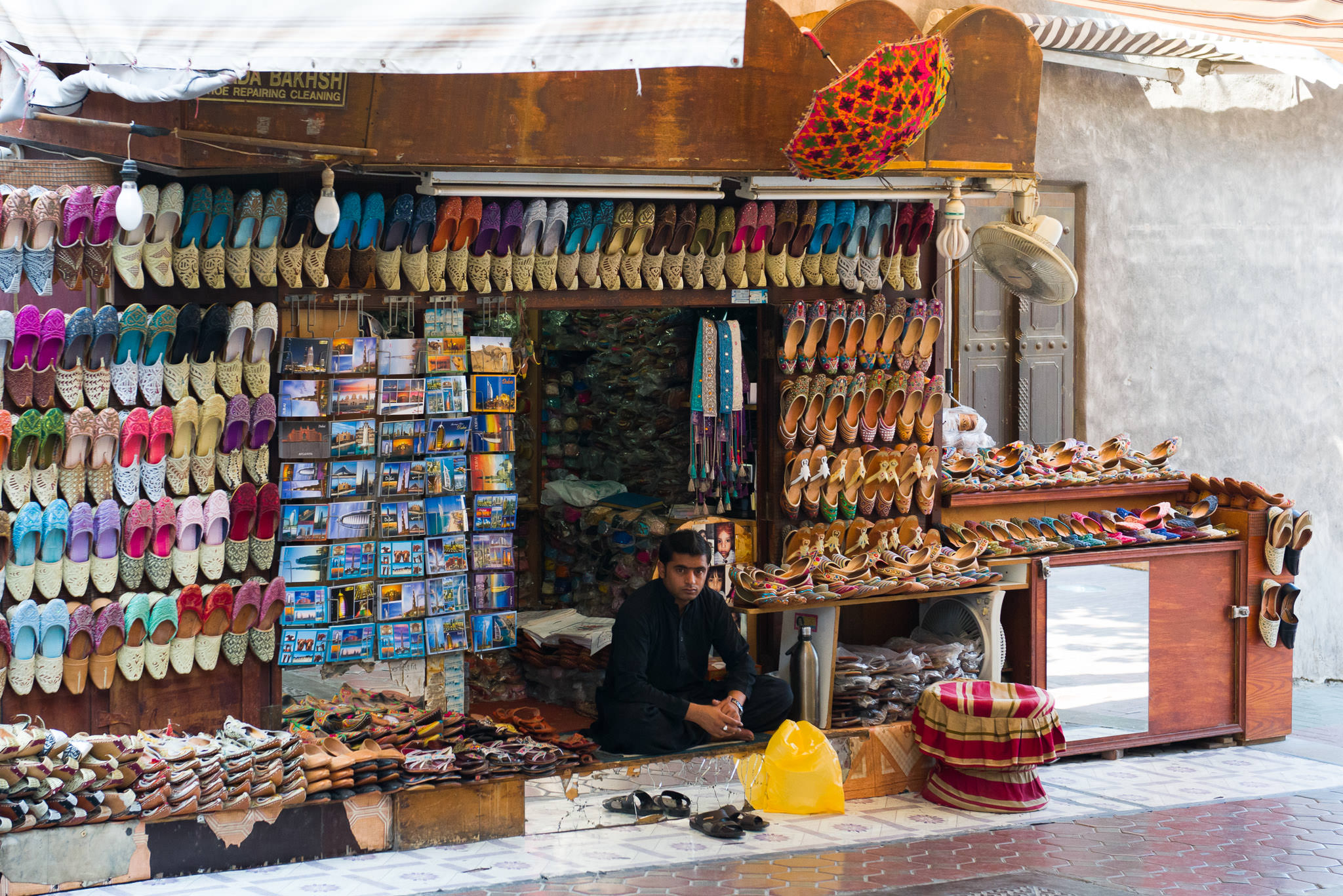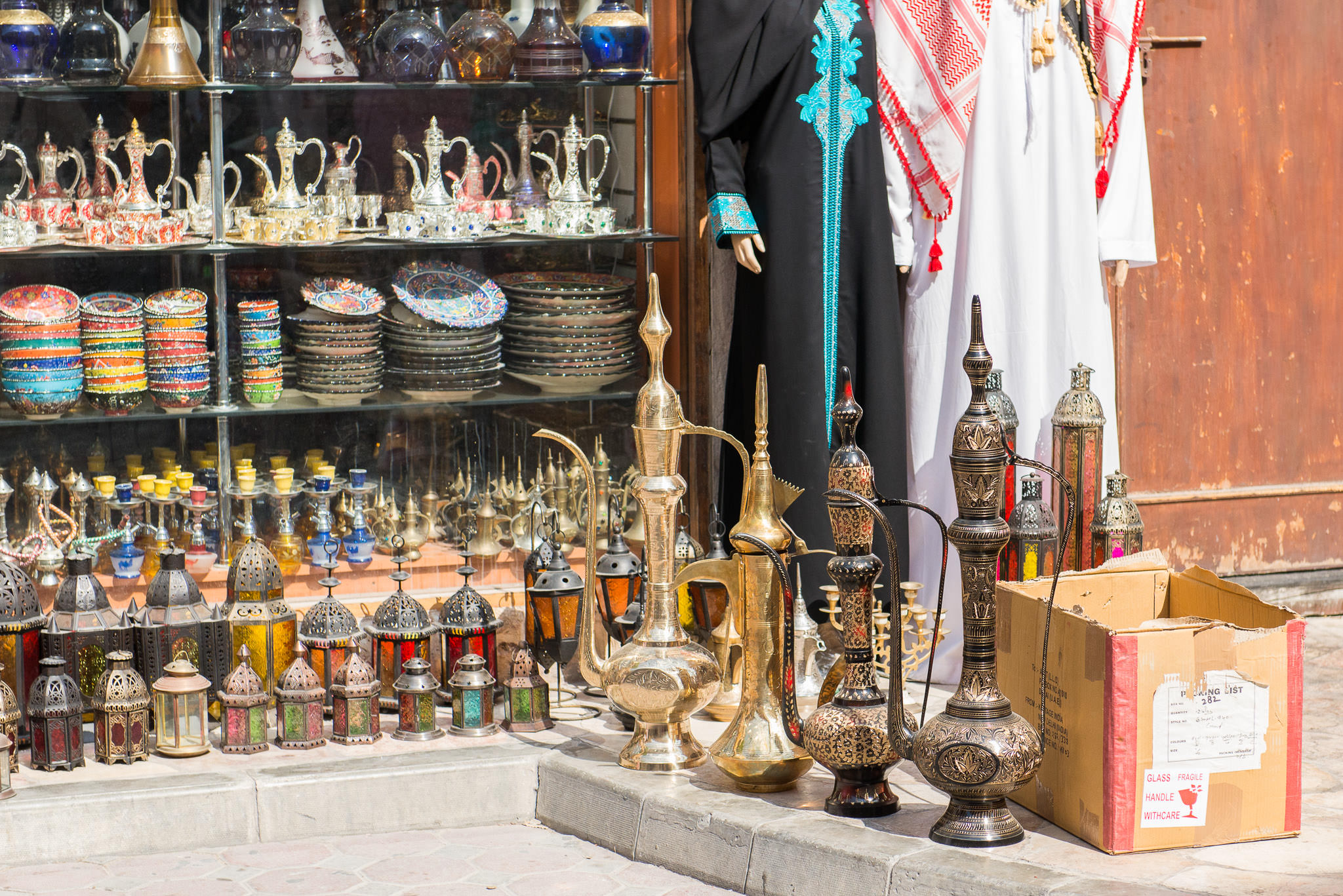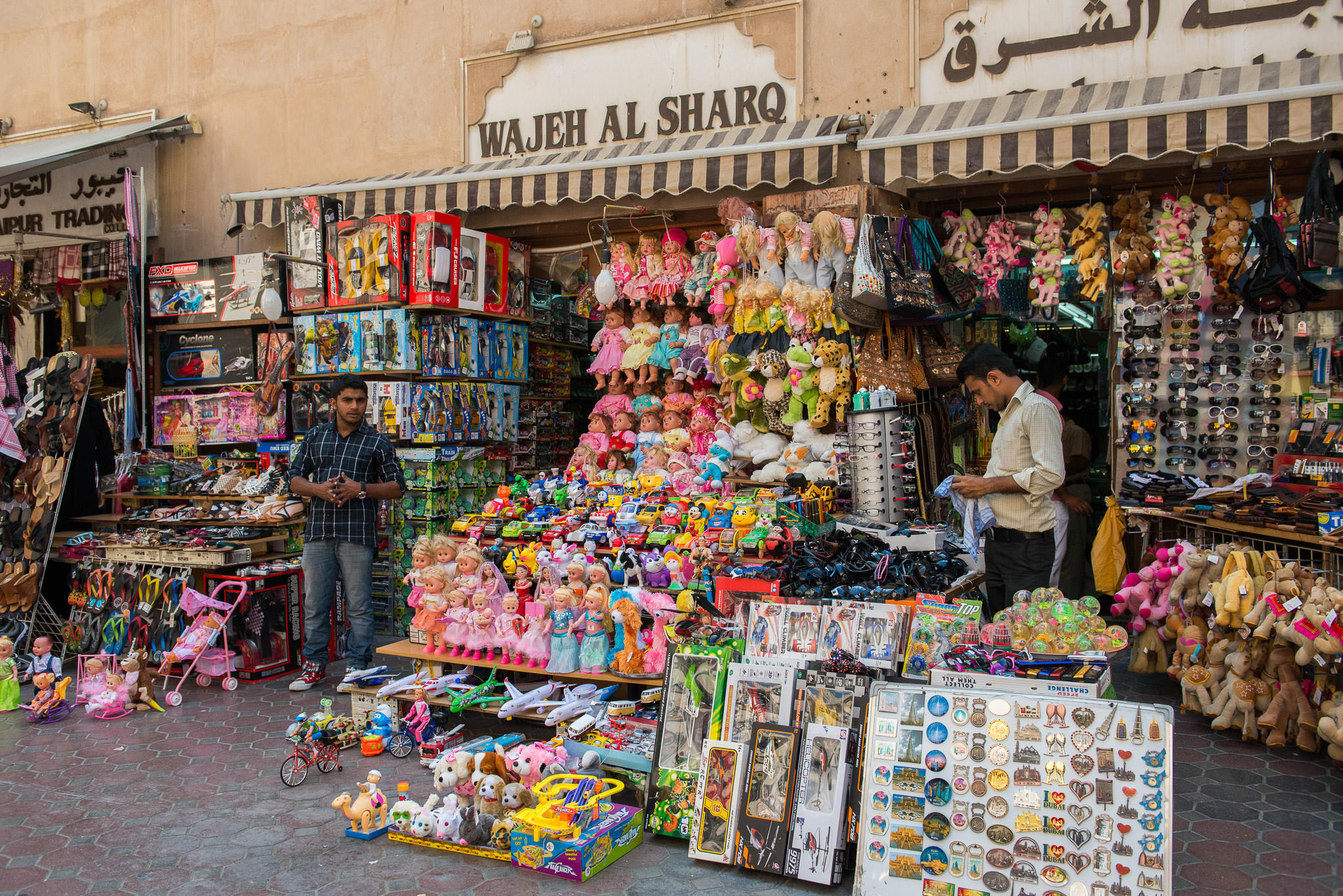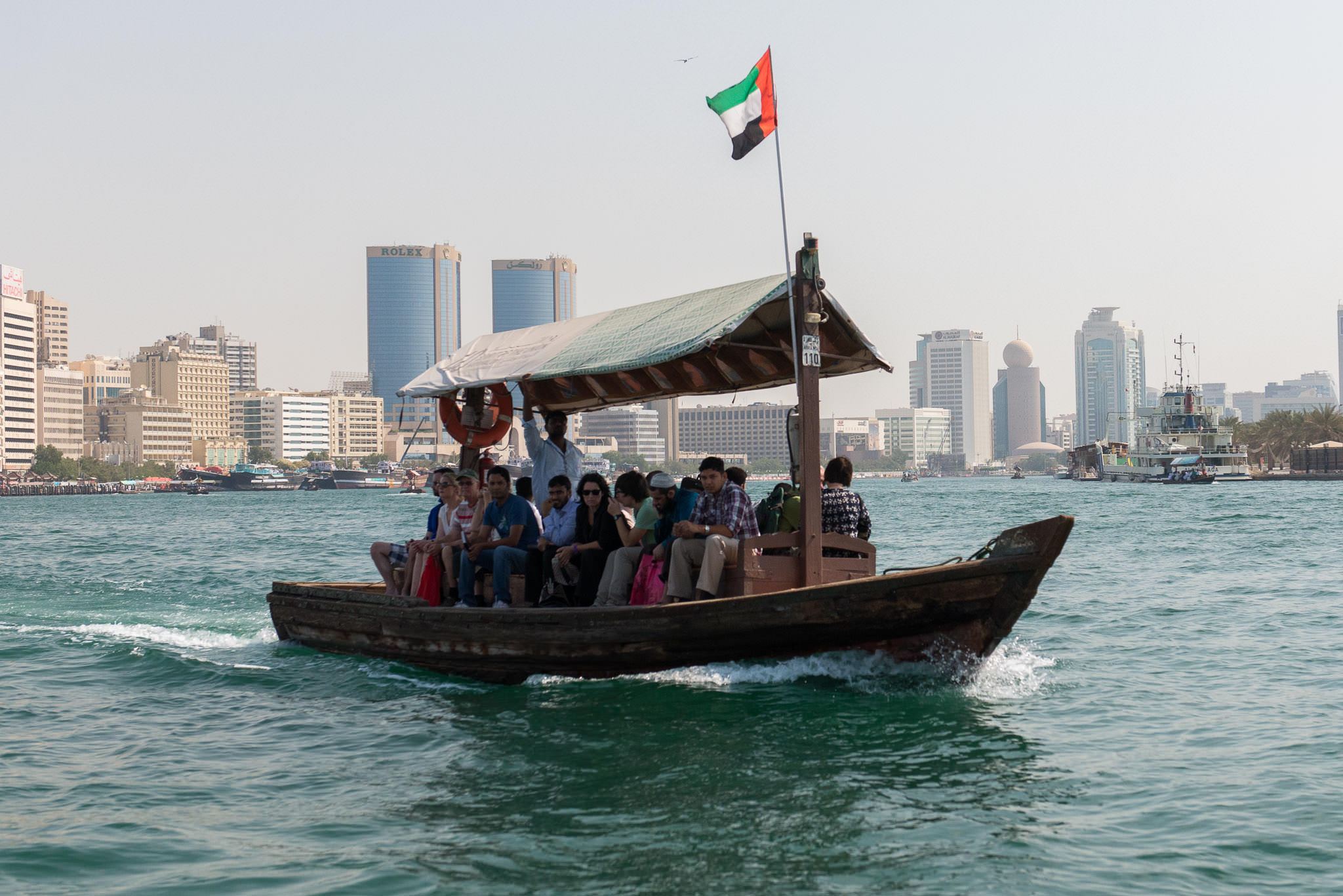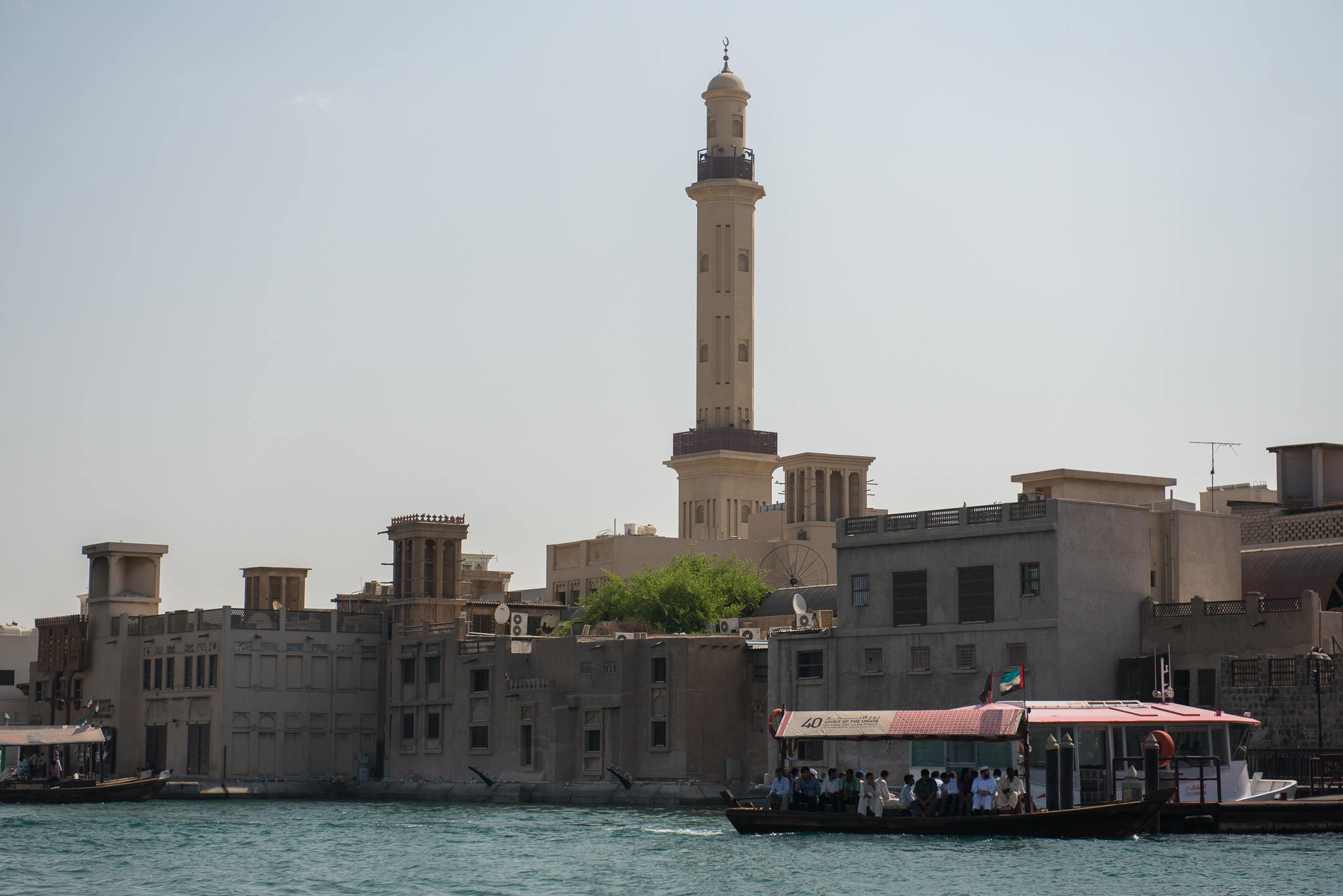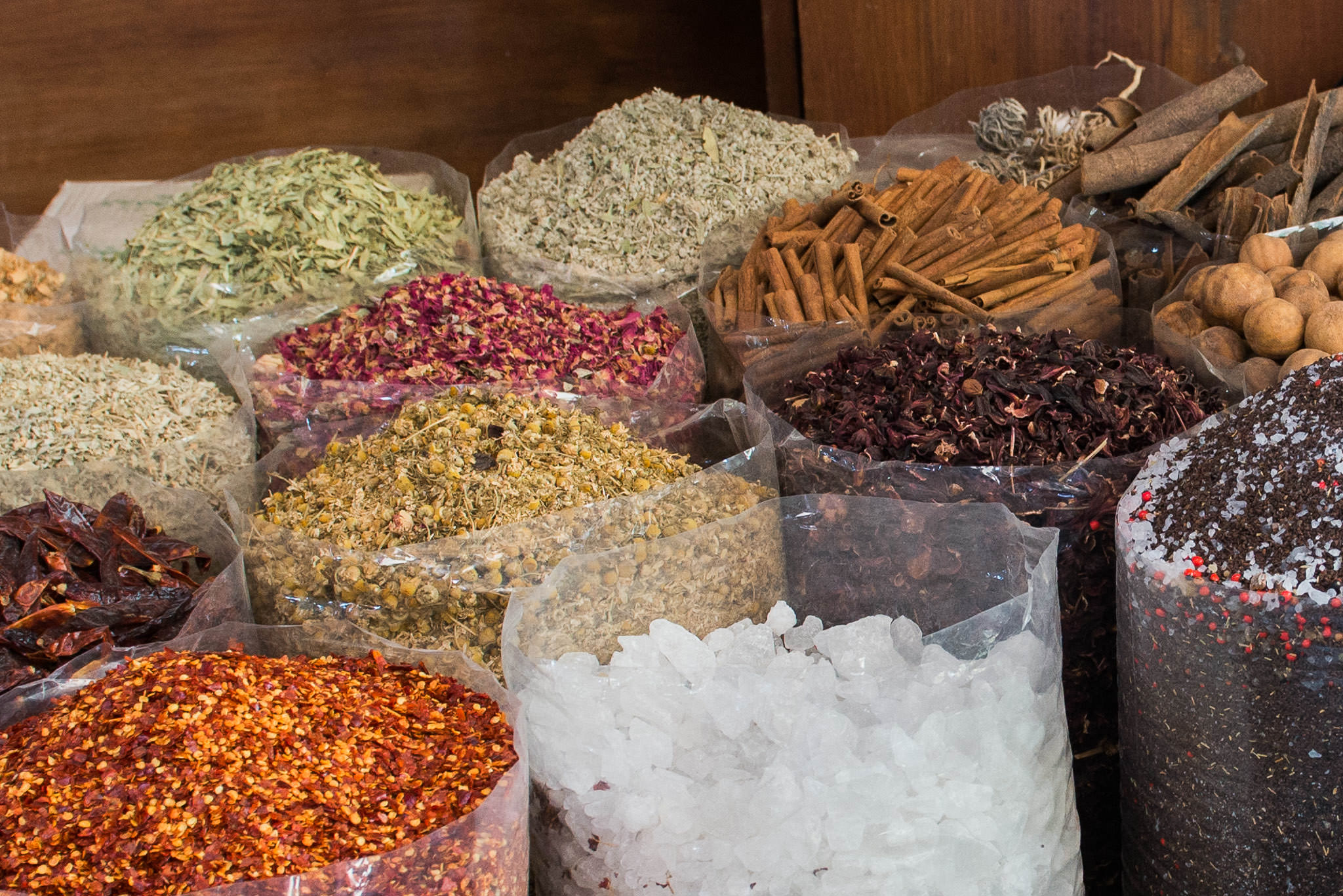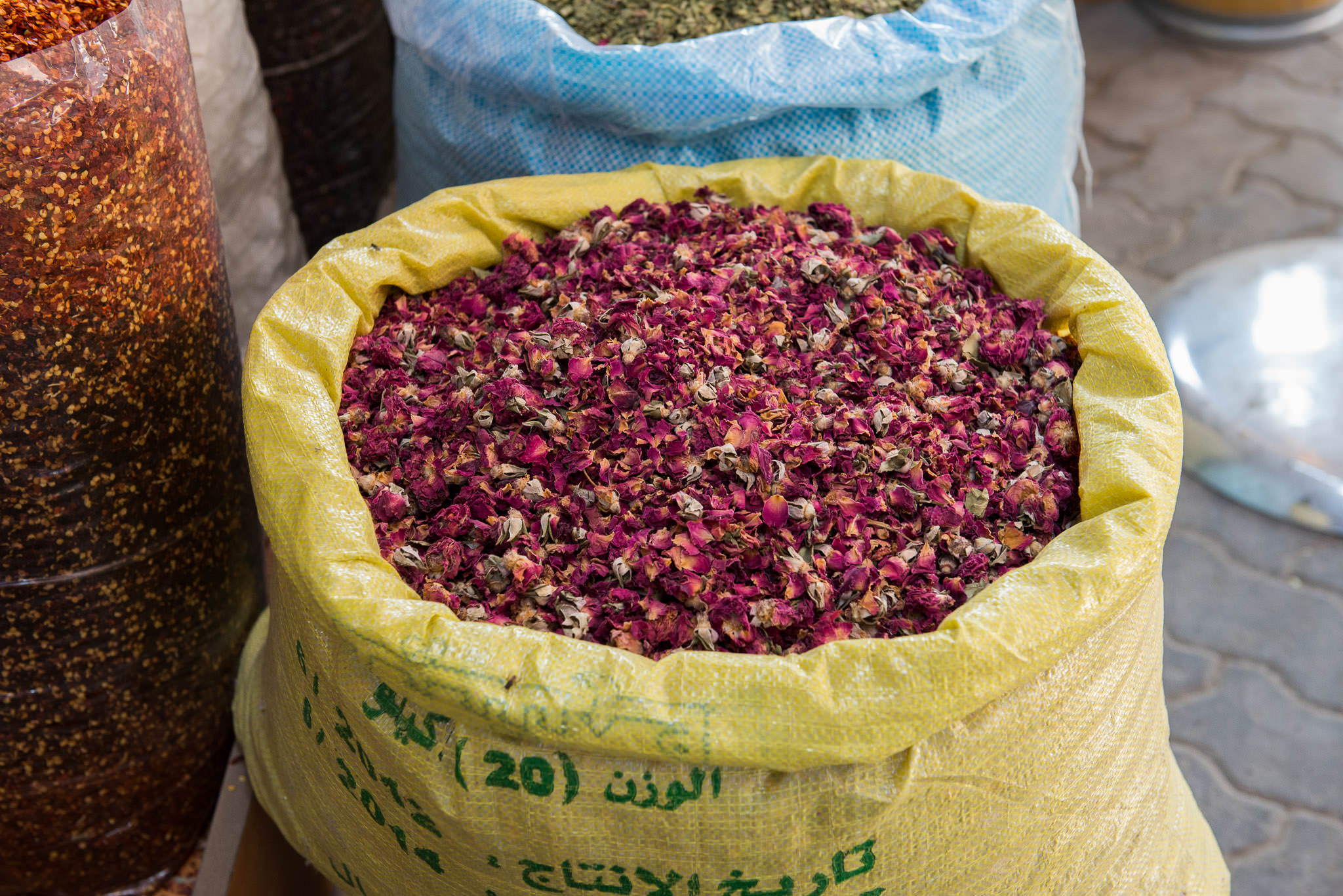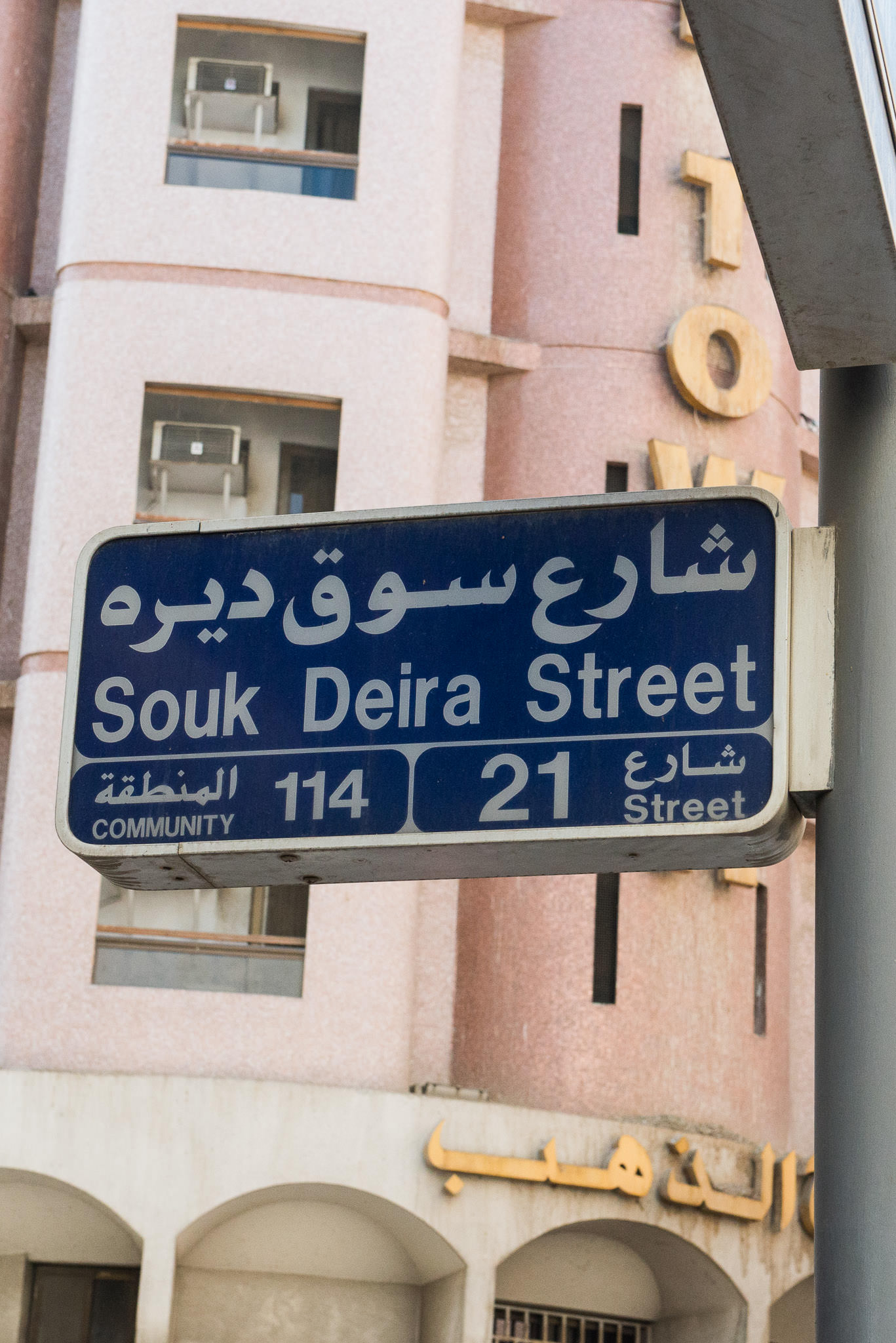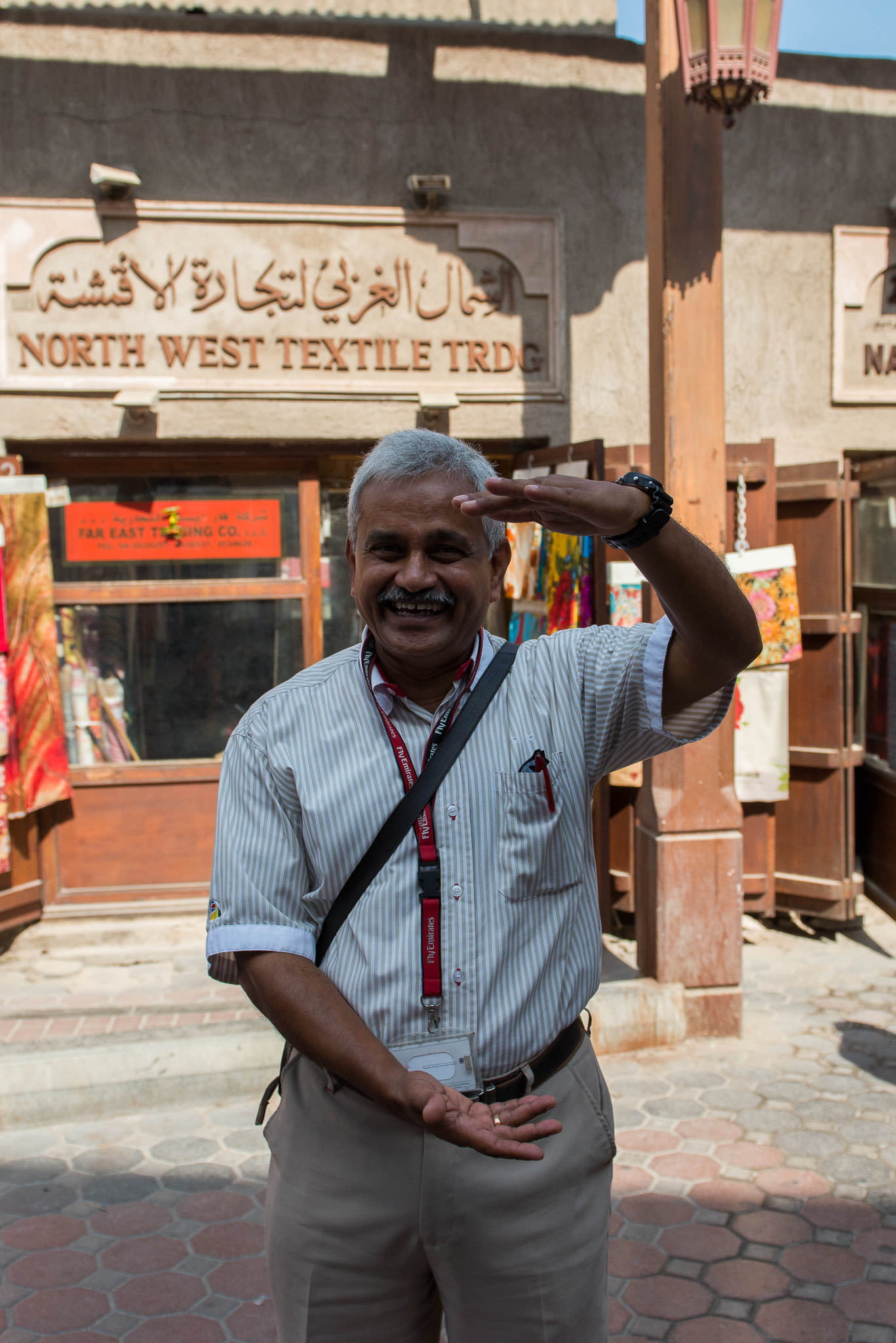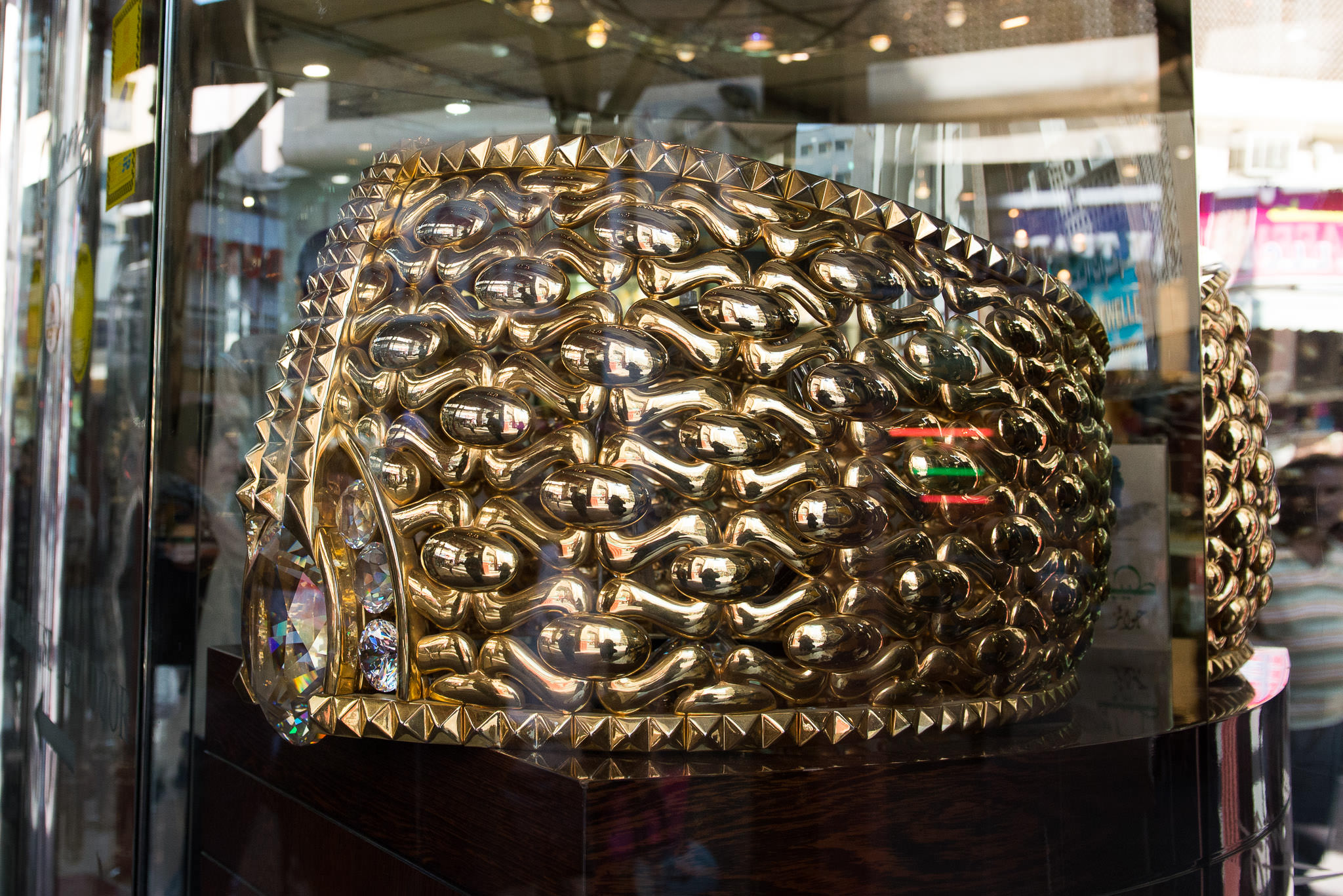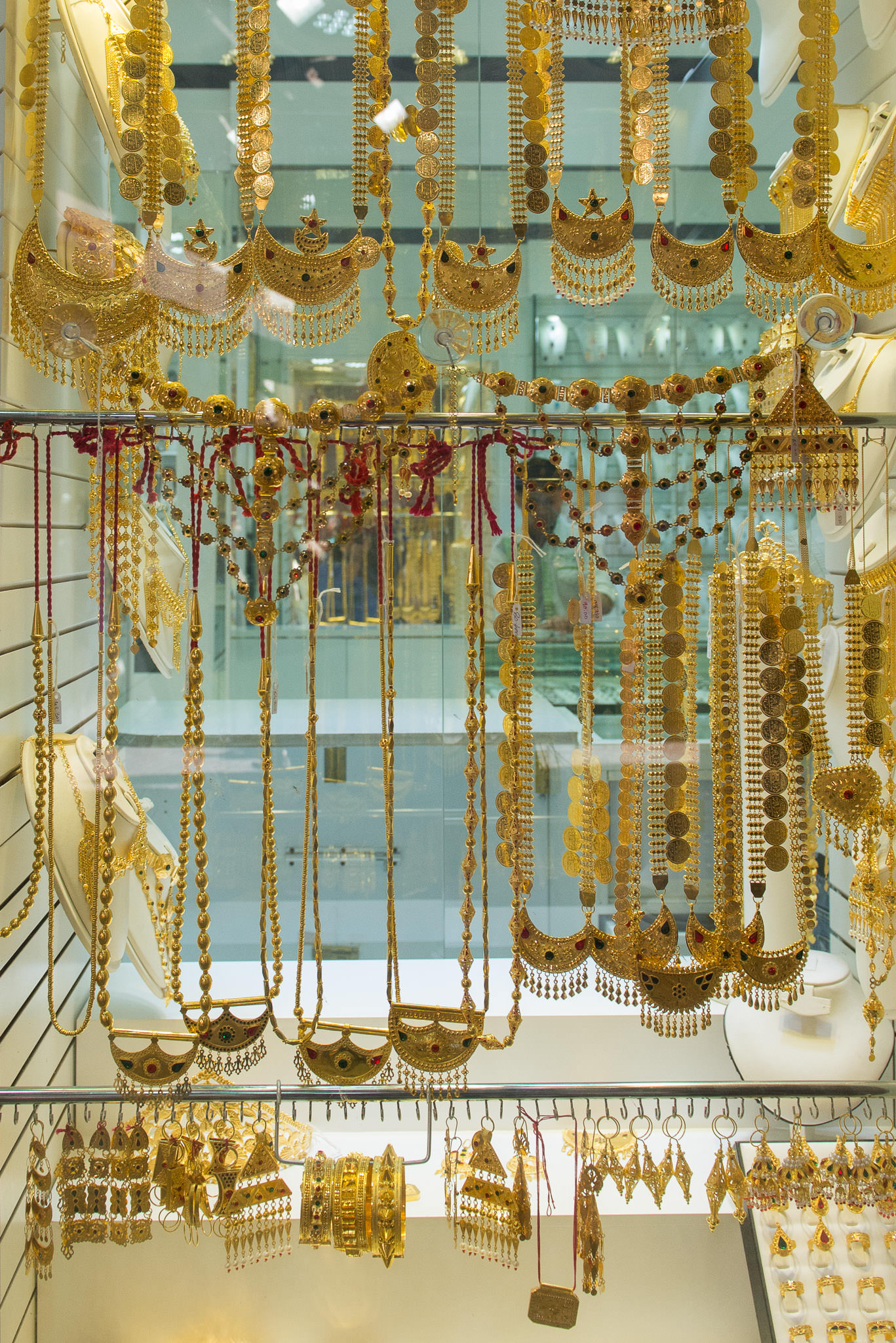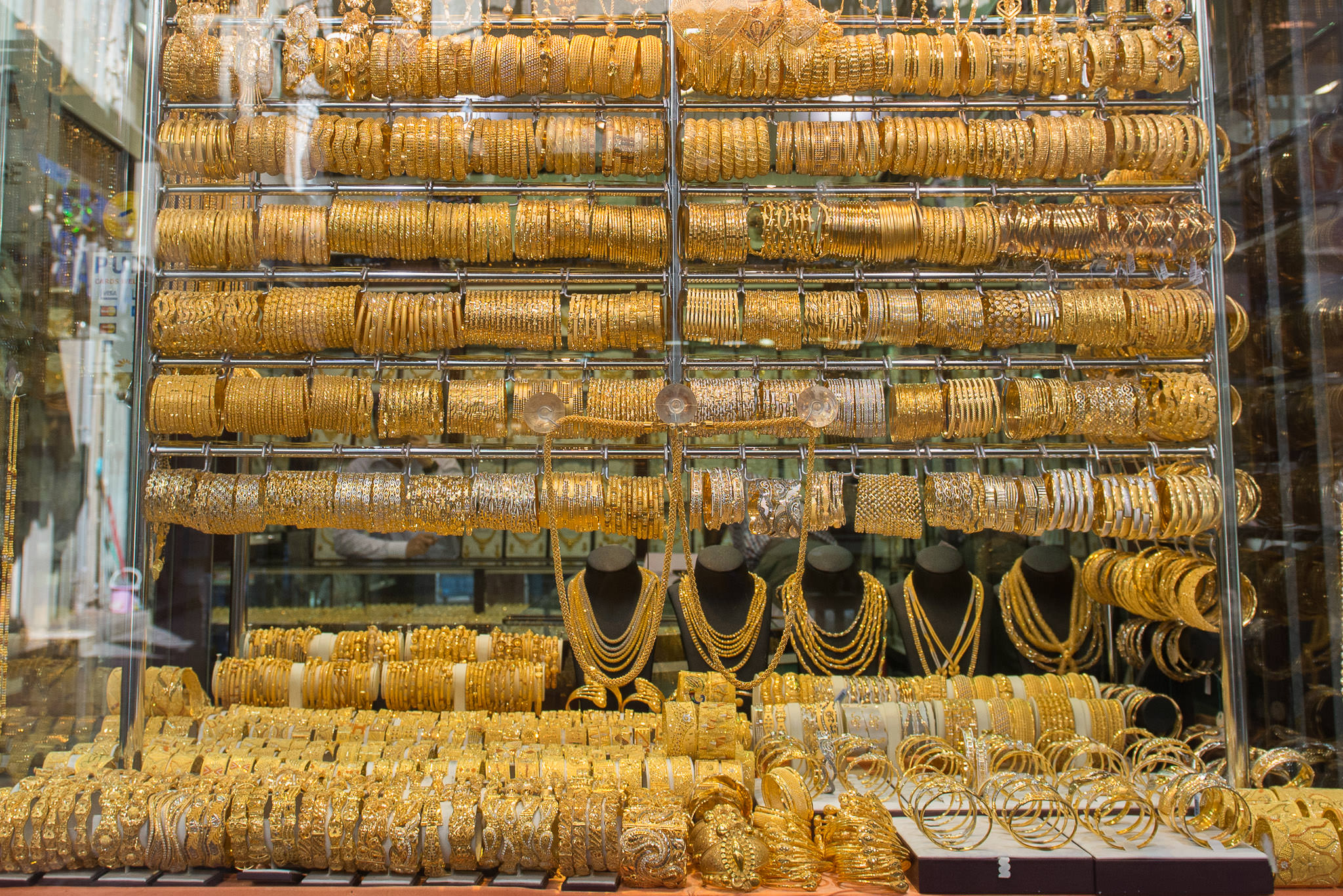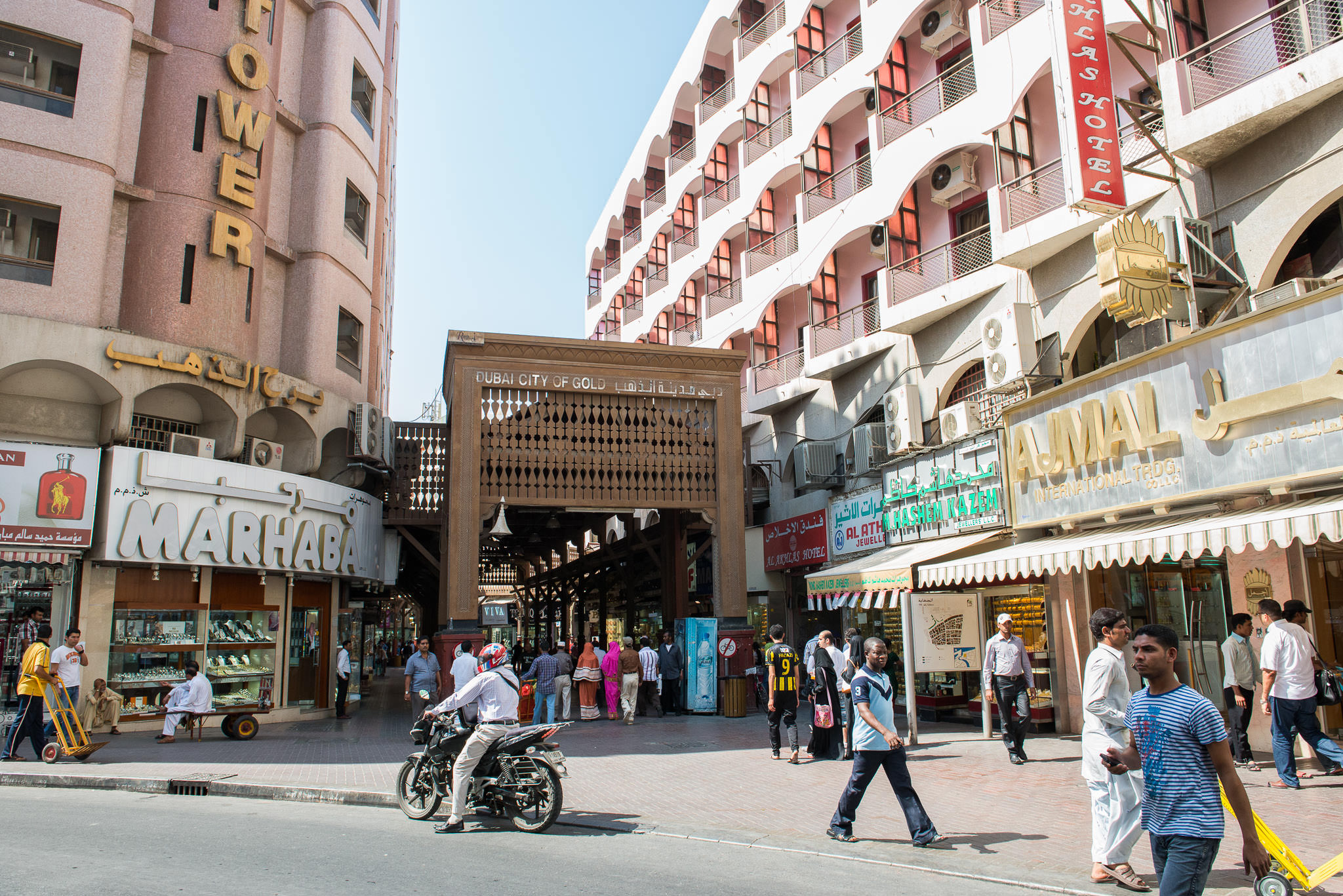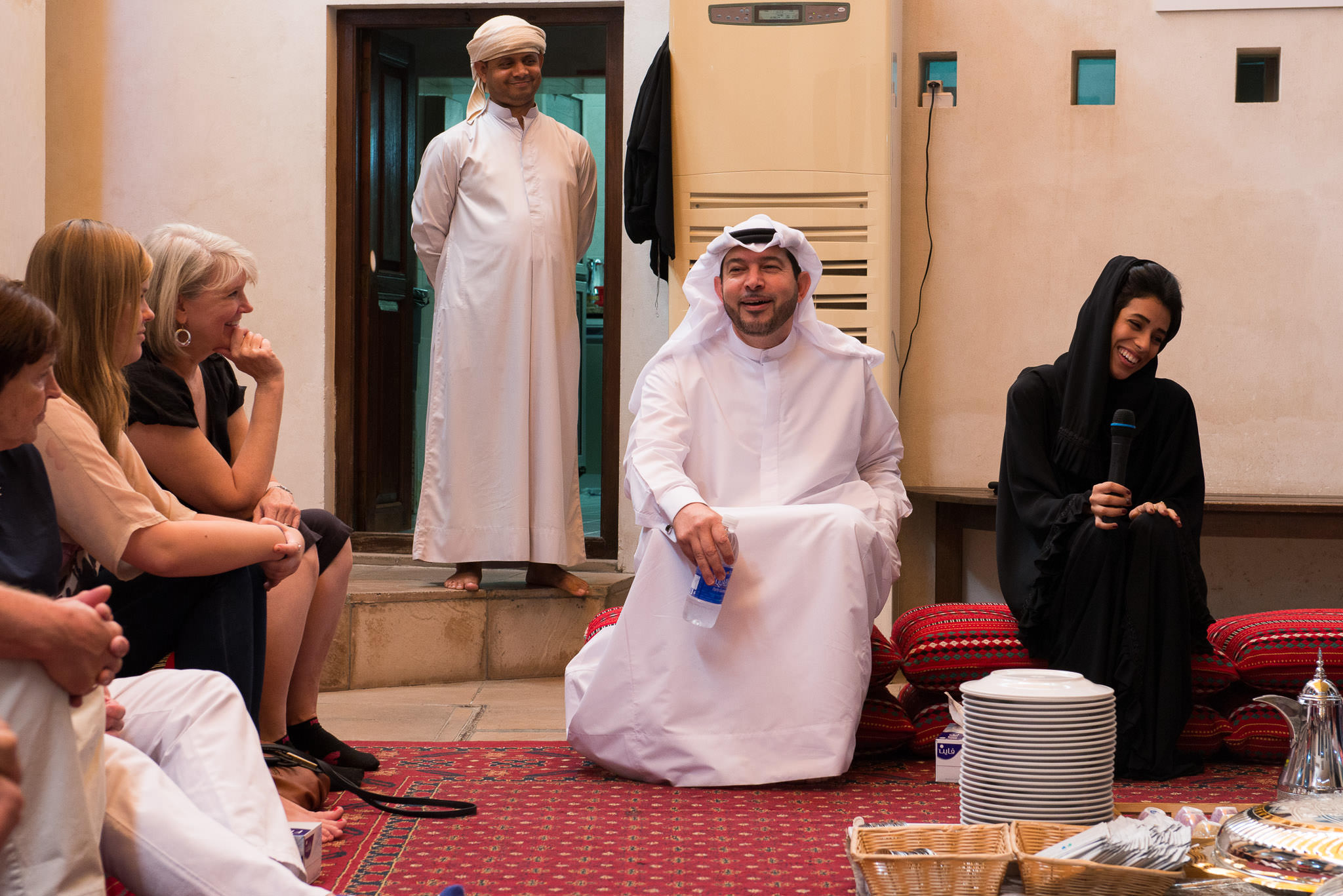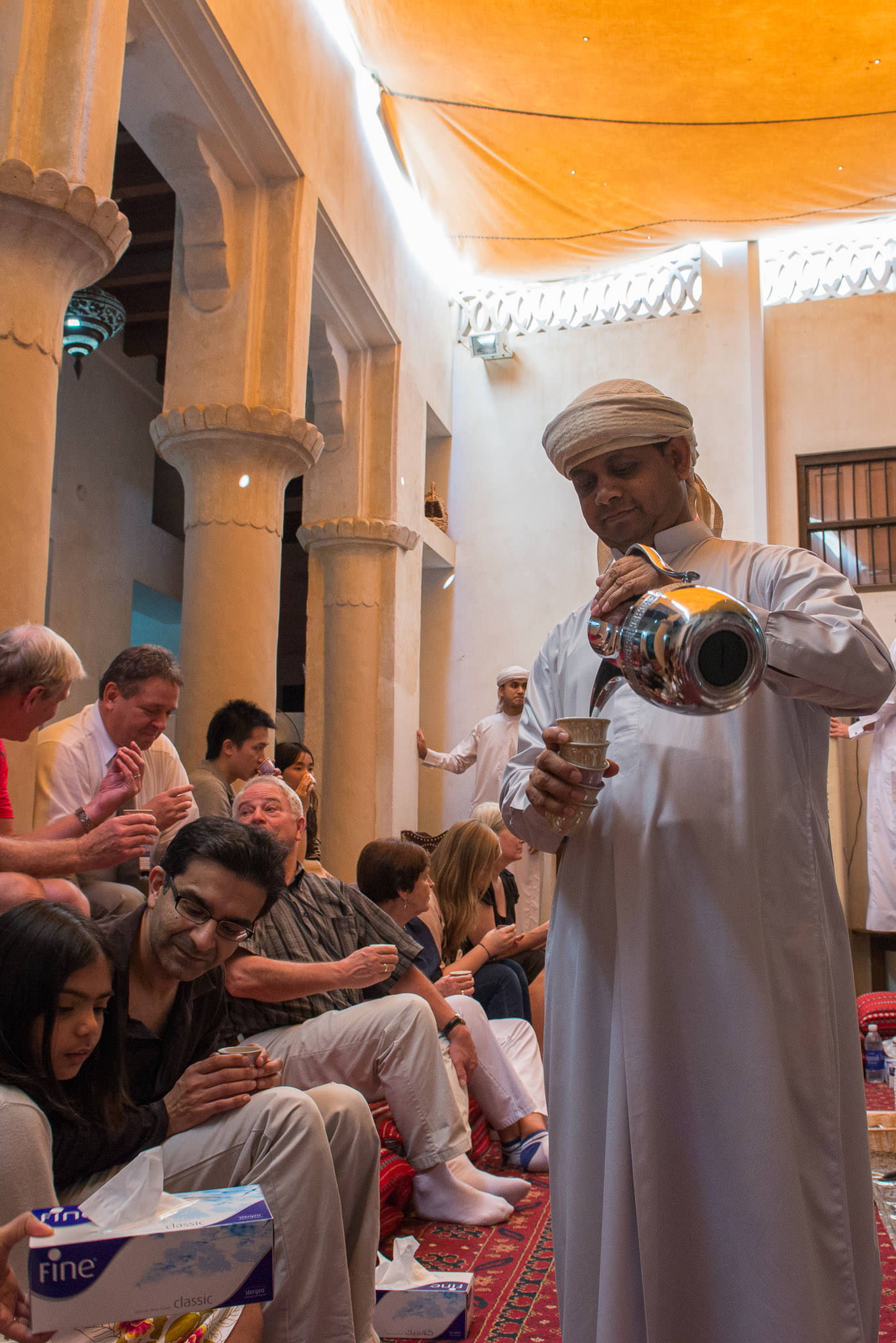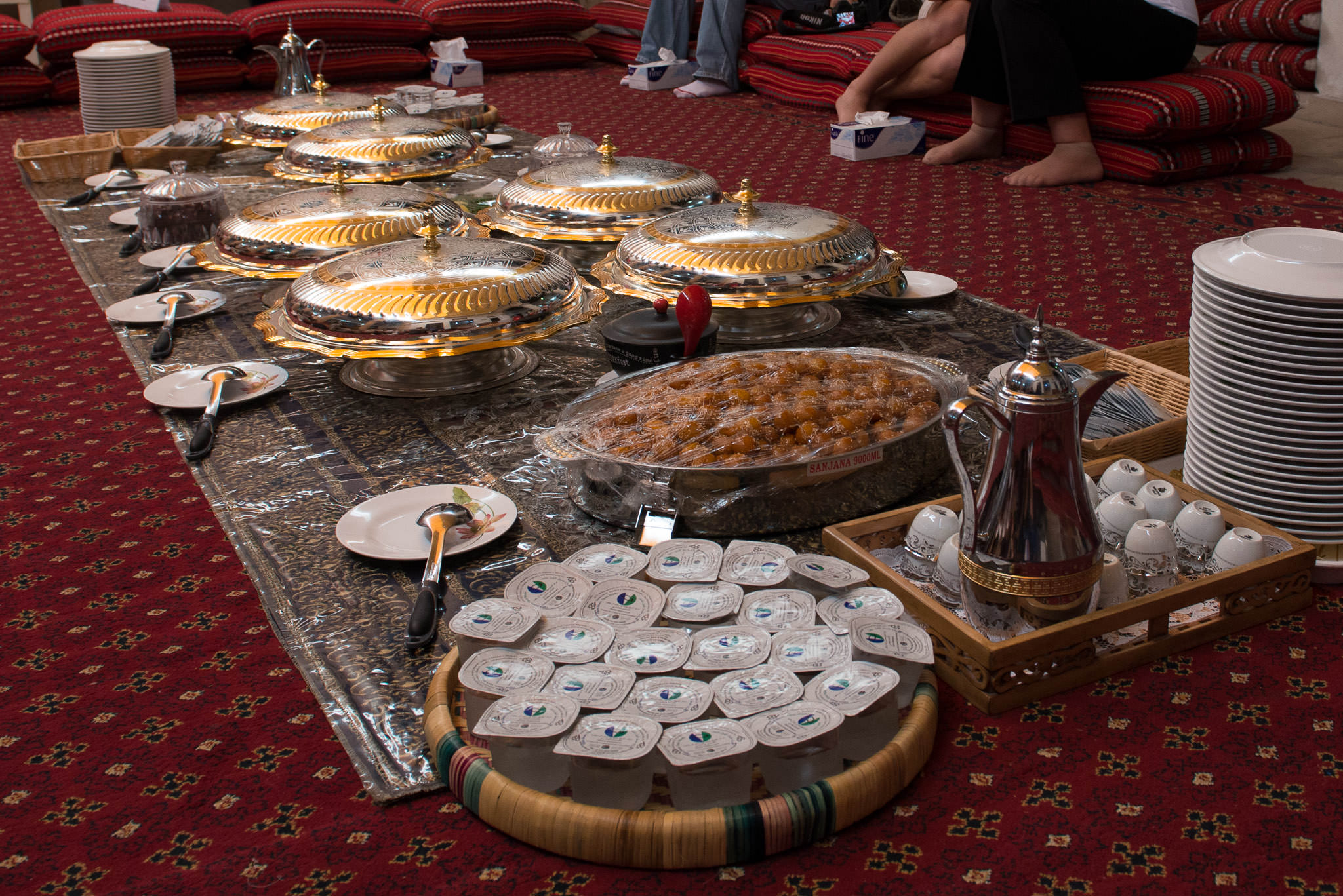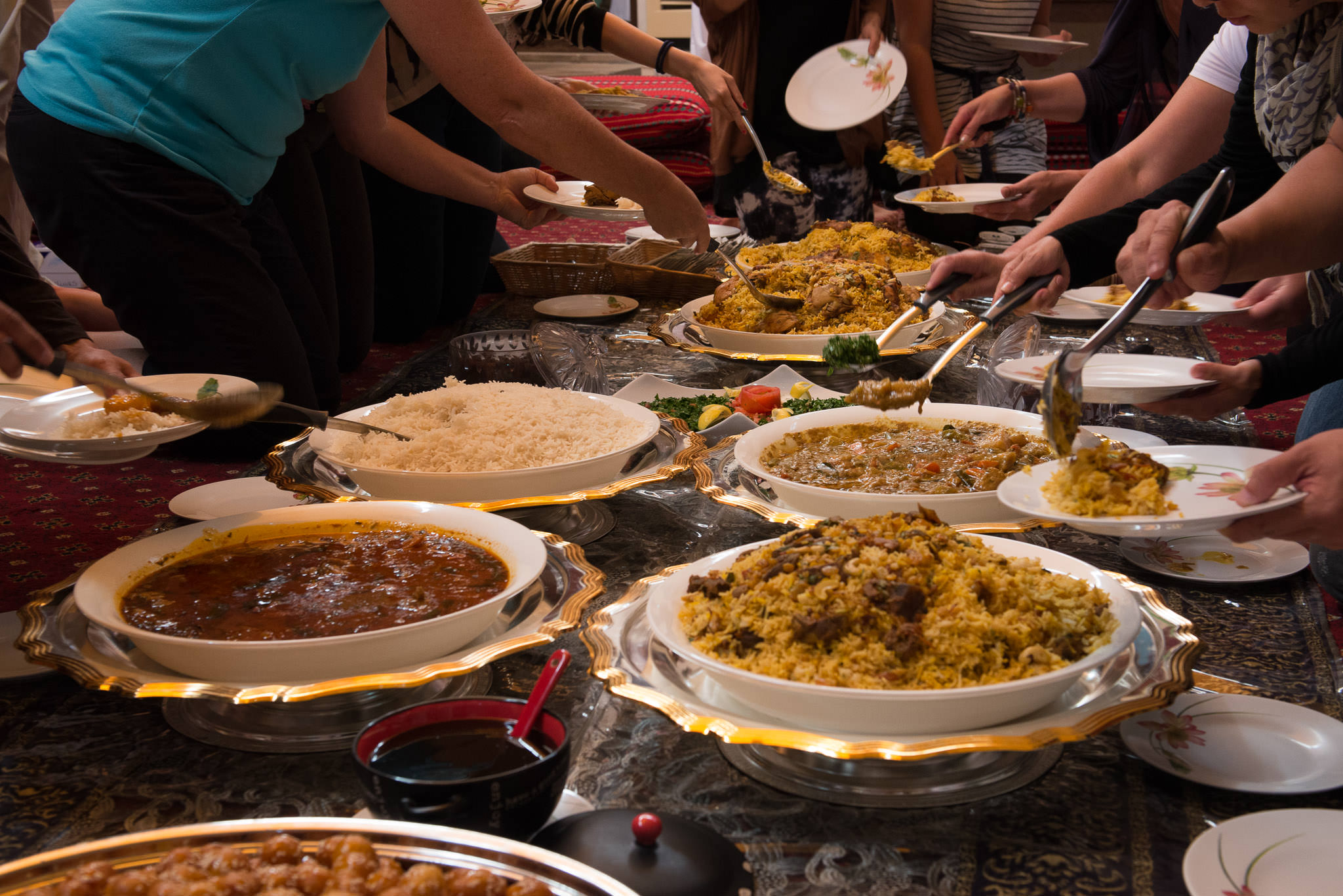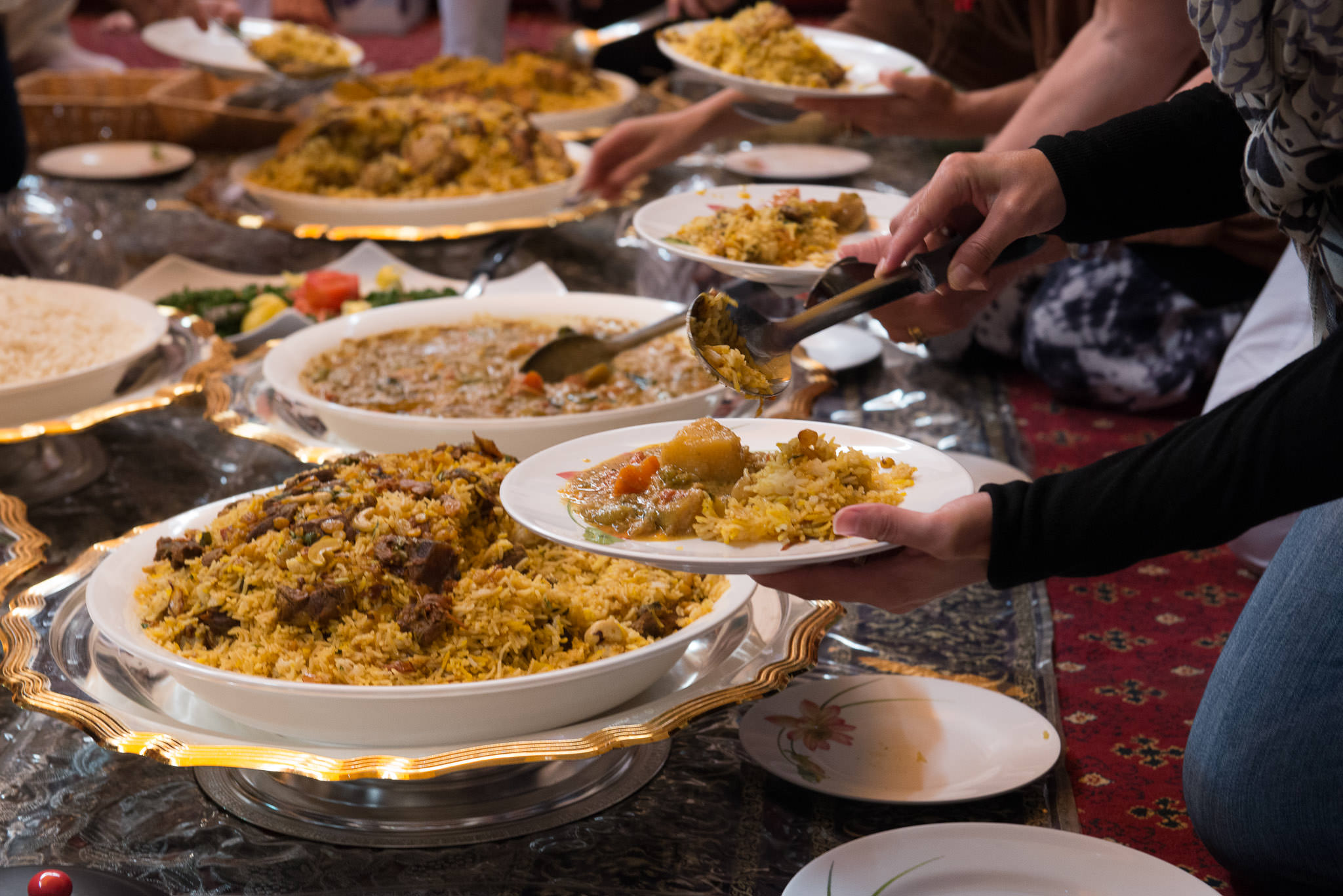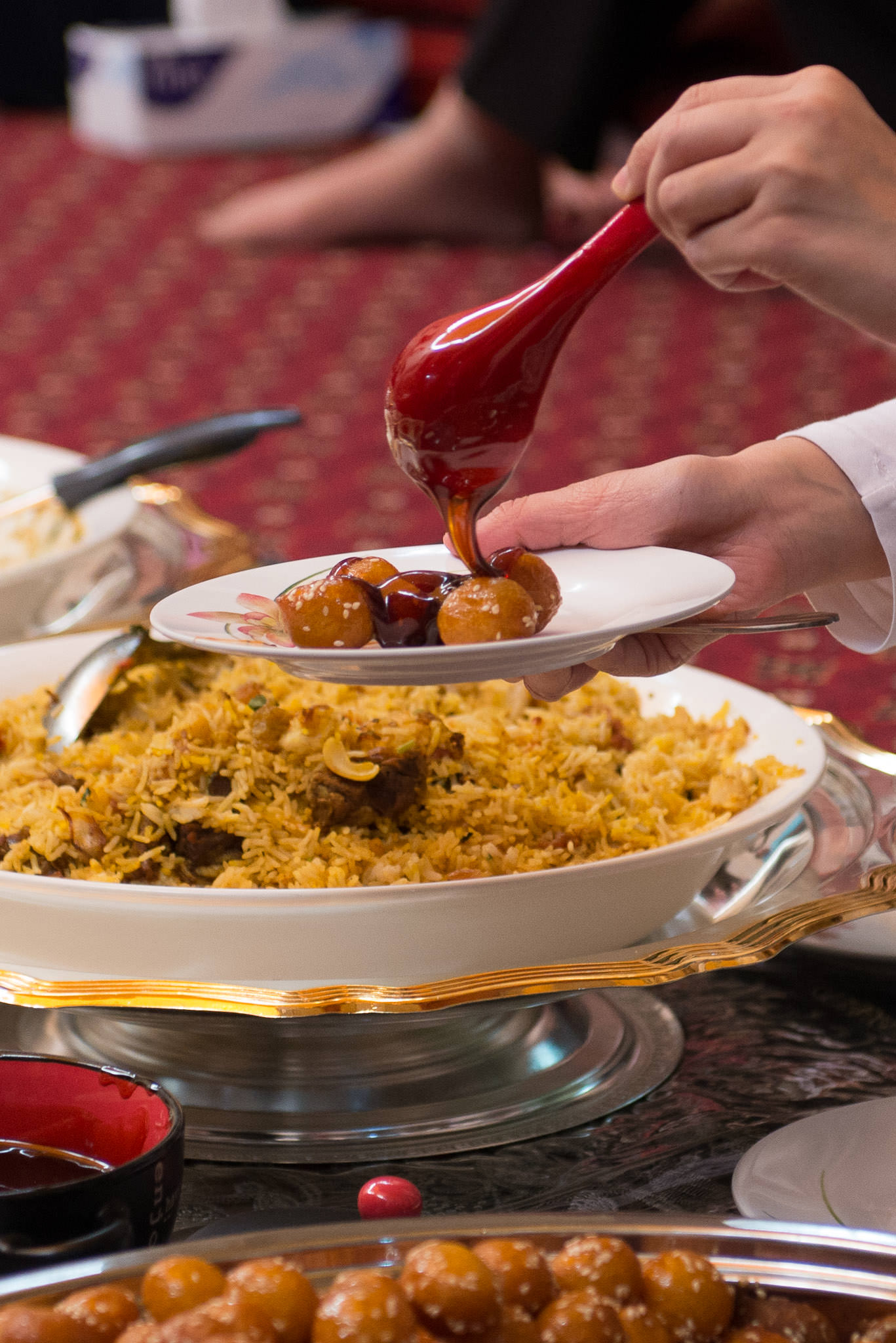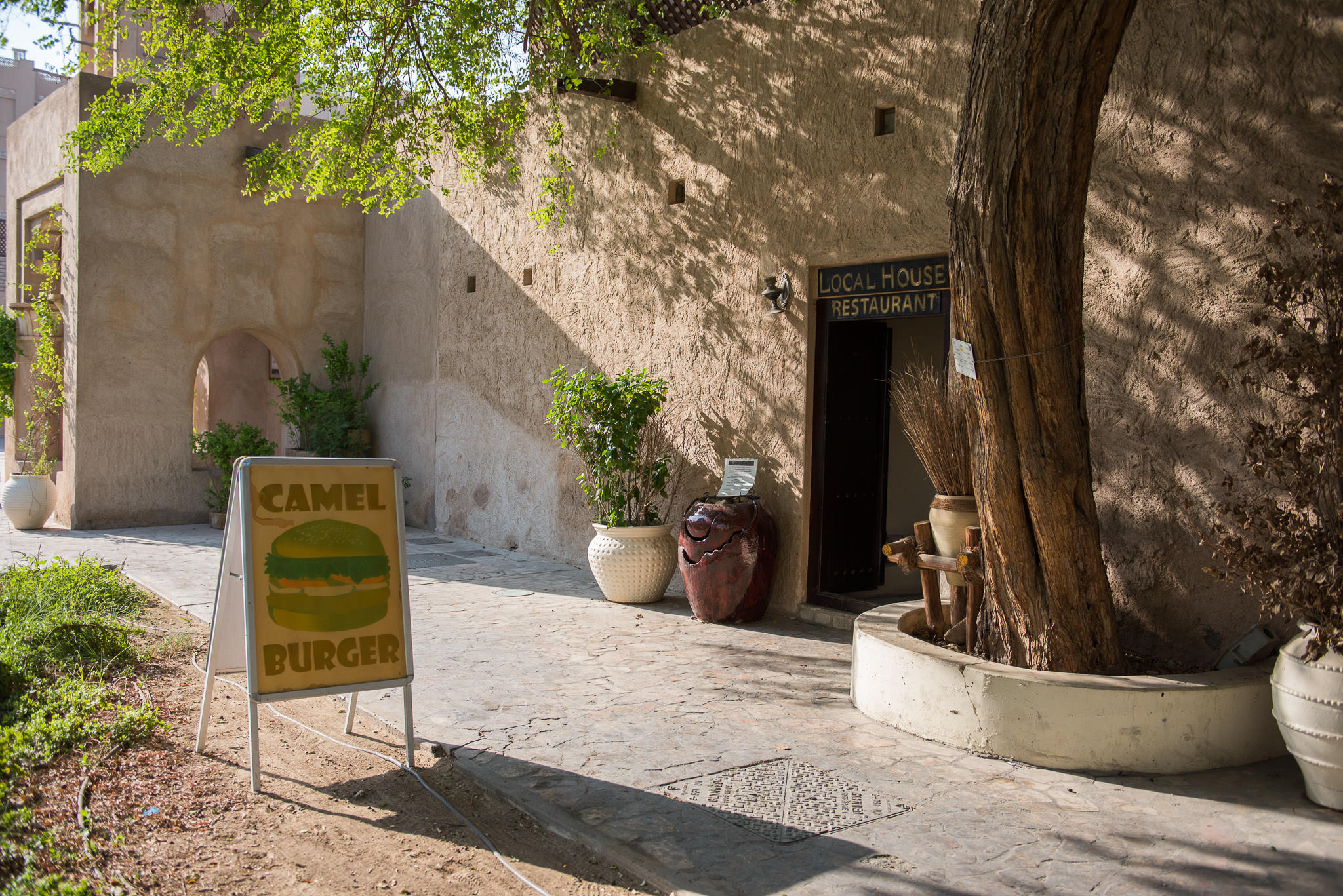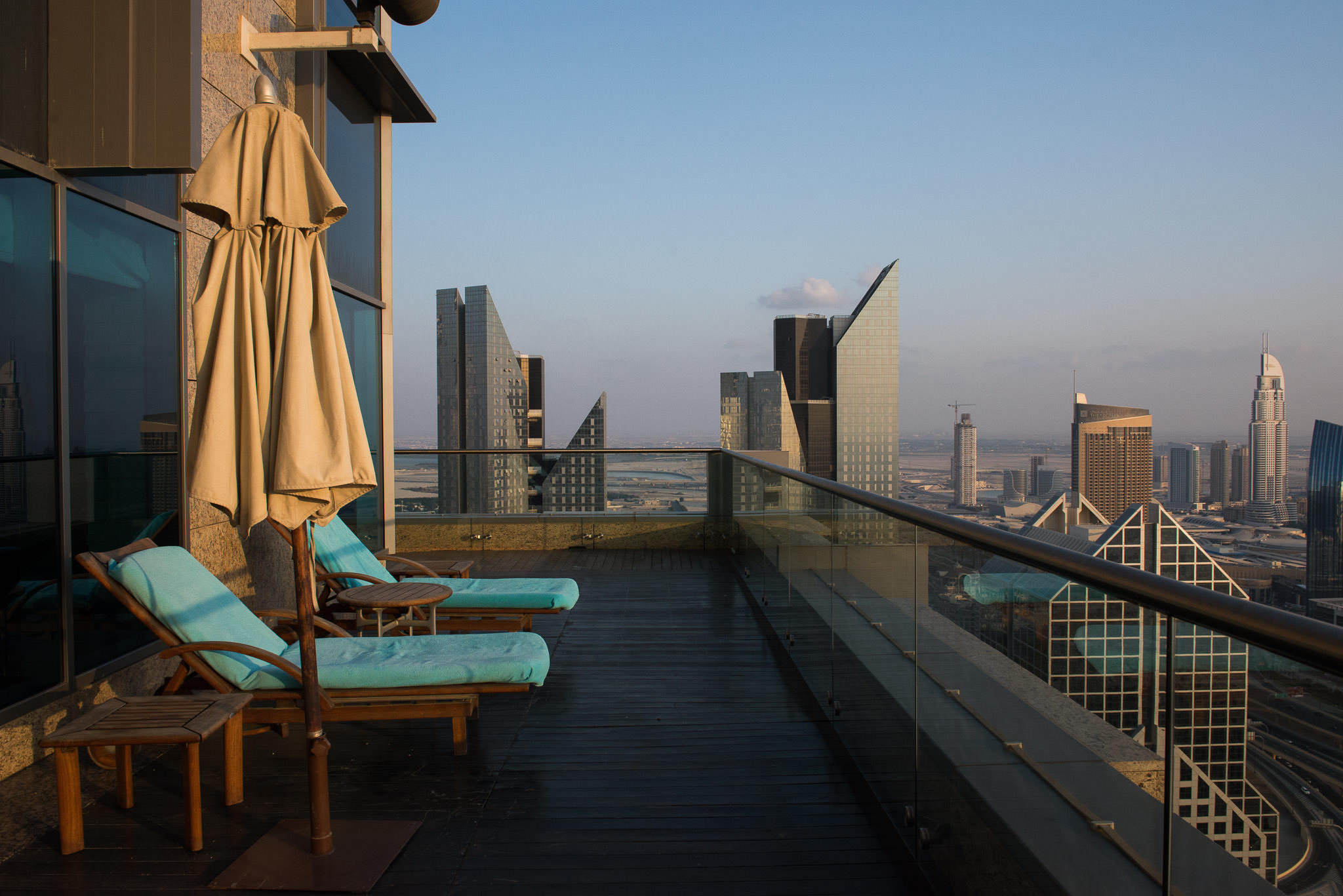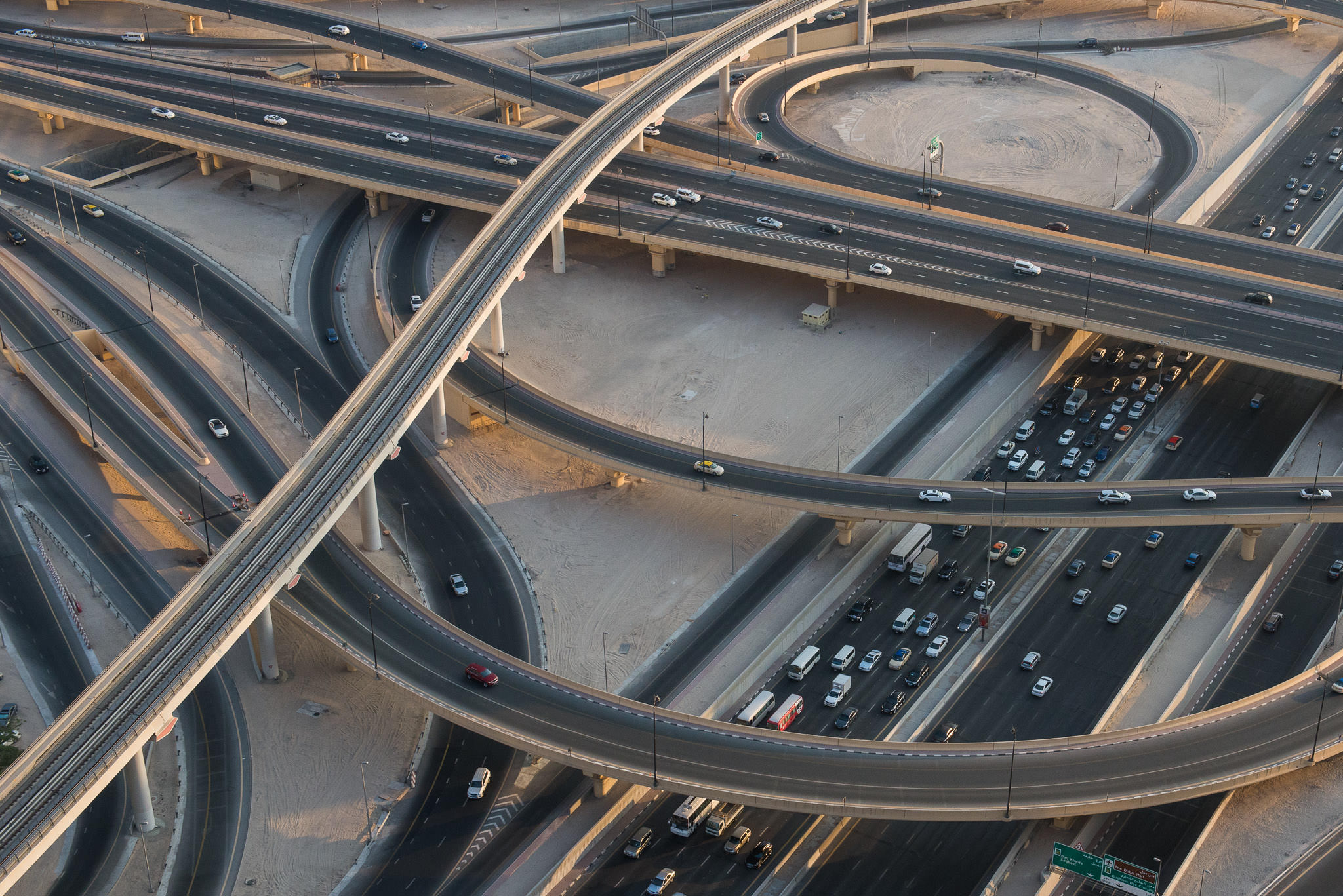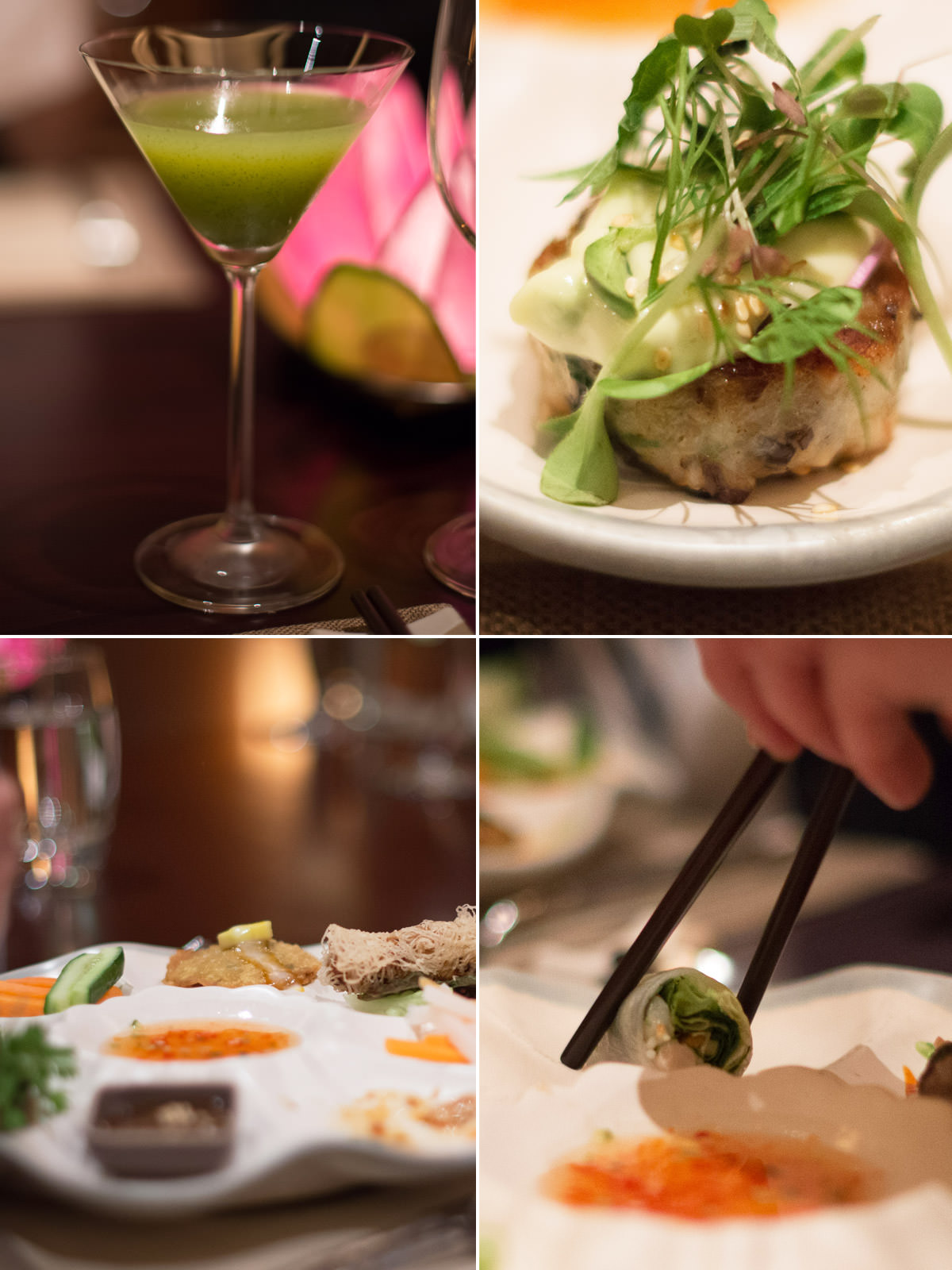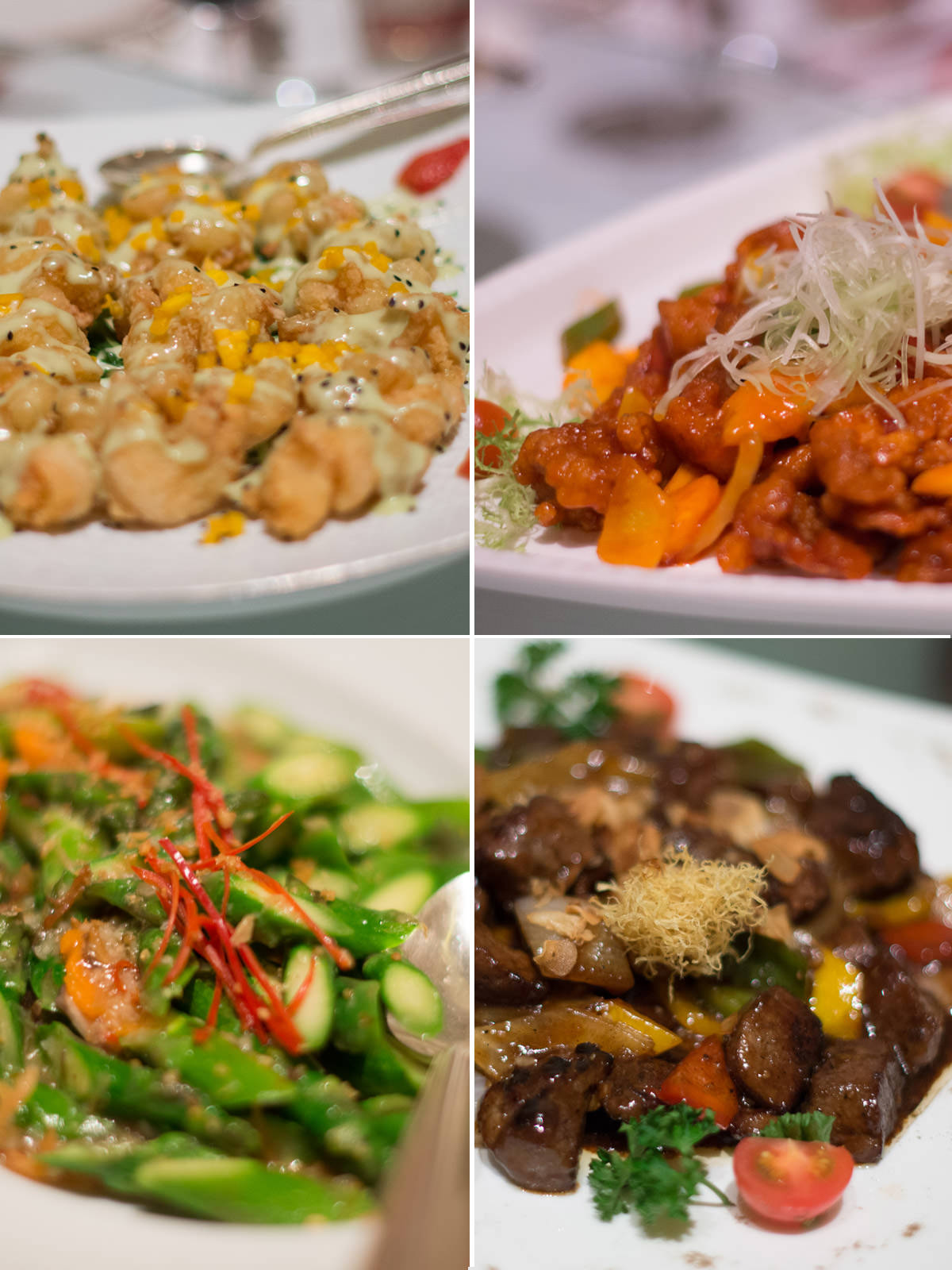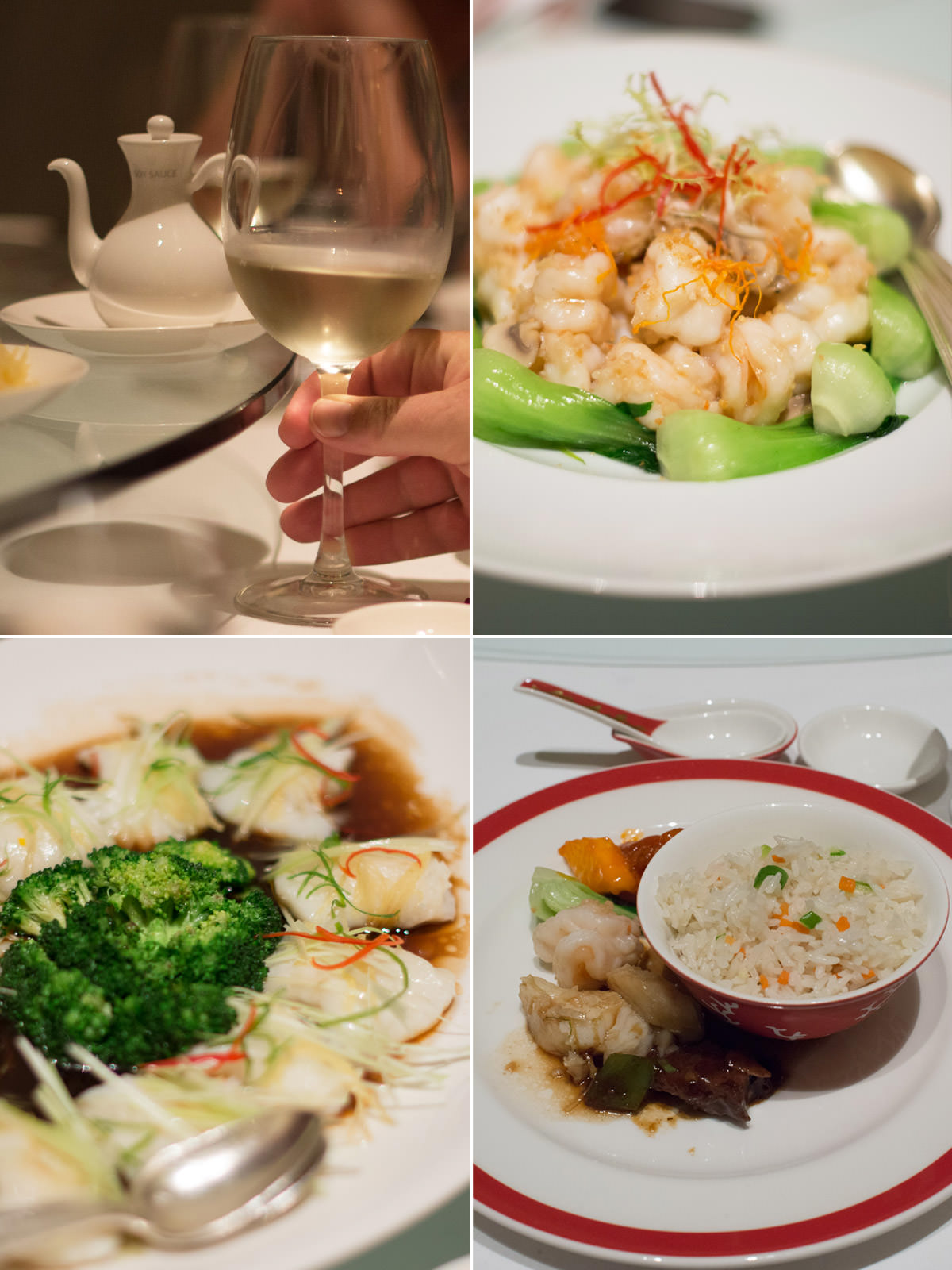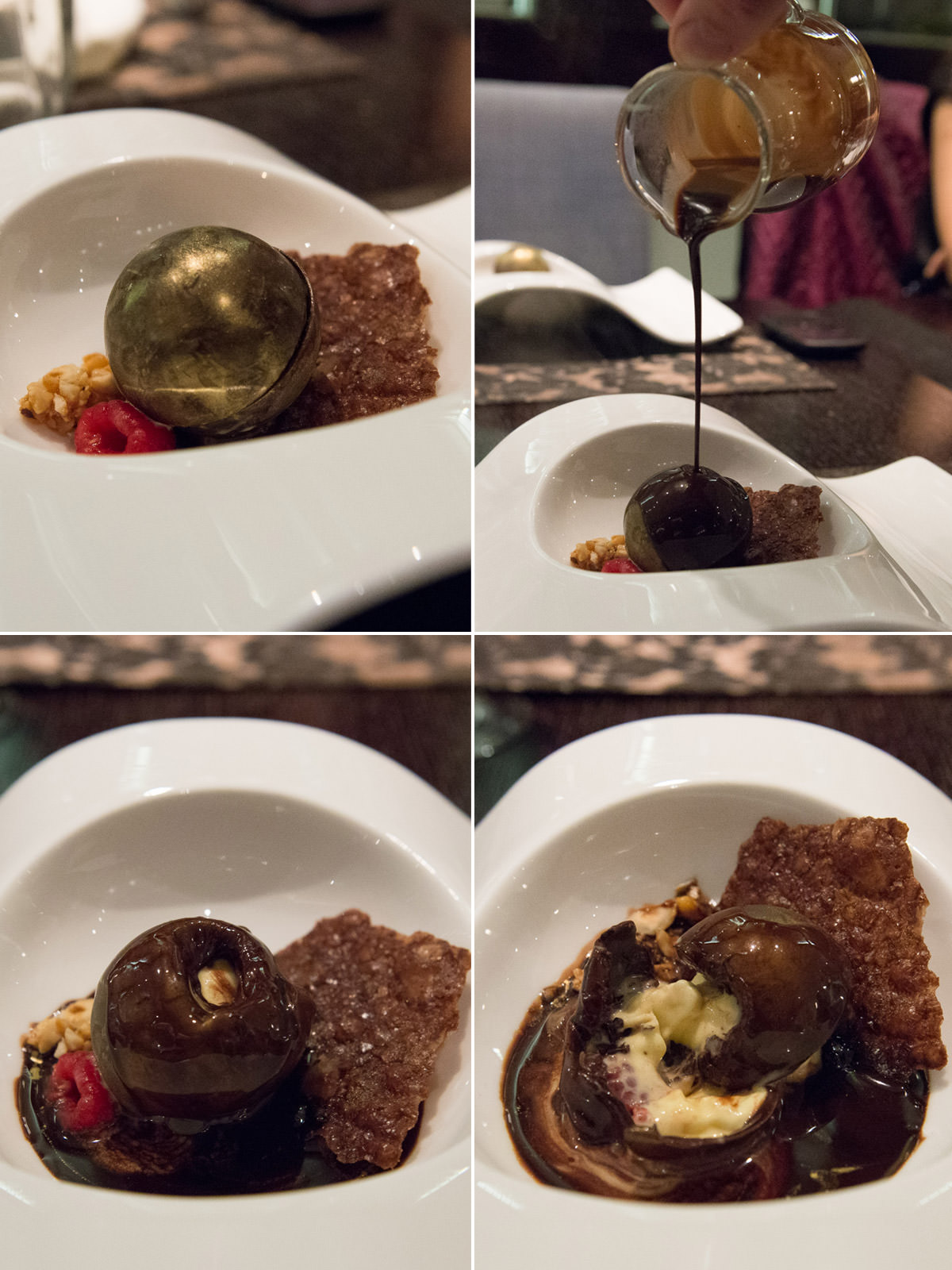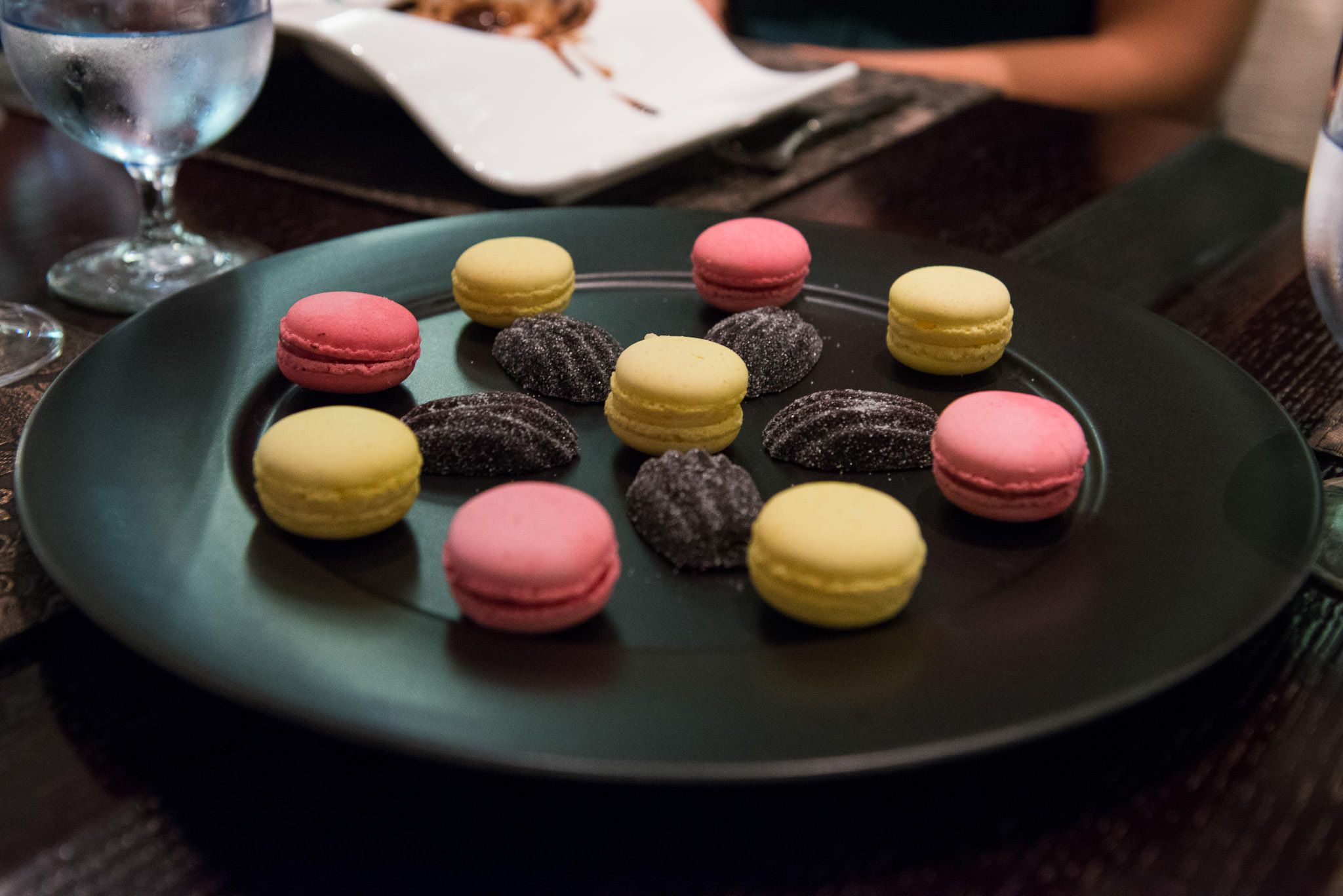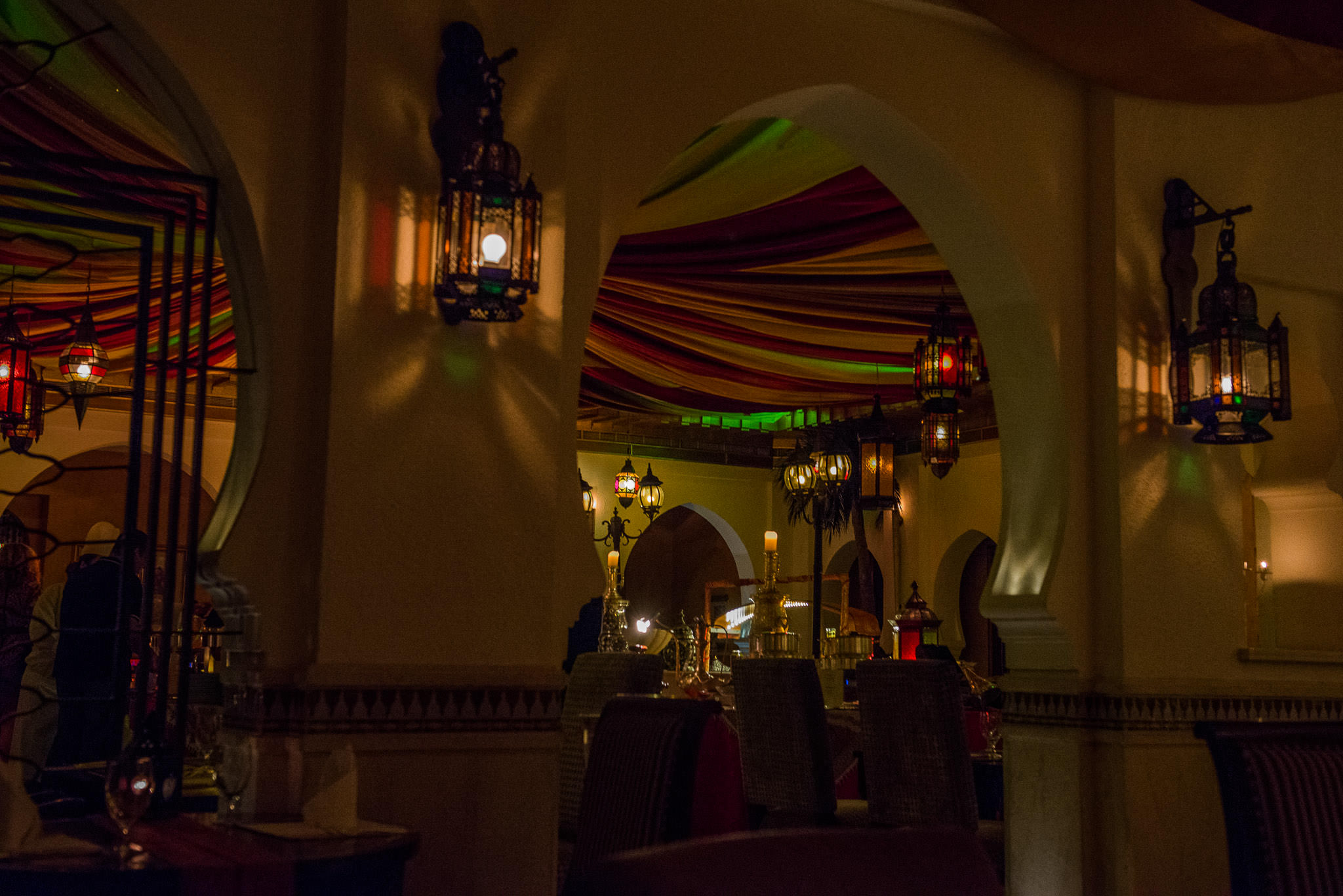Unexpected Dubai: Camel races, textile market, spice and gold souk, cultural lunch and progressive dinner
In October, I travelled to Dubai in the United Arab Emirates as a guest of Emirates and the Government of Dubai, Department of Tourism and Commerce Marketing. This is the fifth post in my blog series on that trip.
Camel races
Our day began early. We boarded our mini bus, bleary-eyed and quieter than usual on the drive to the camel racetrack on the outskirts of Dubai.
Pretty soon, camels everywhere, covered with colourful blankets, some wearing crocheted muzzles.
Usually, on my trips, there’s at least one activity that leaves me with smelly or dirty shoes, be it walking through dank, bat poo-spattered caves, muddy temple ruins or wet markets slimy with fishy water, blood, fat and guts. Here in Dubai, my smelly shoe event was walking through the camel urine-soaked sandy area where trainers and camels assembled before their races.
Handlers prepared for the next race, strapping robot jockeys to the back of their camels, complete with the metallic whip which would be controlled by remote during the race. In the past, the camels were ridden by child jockeys but they were replaced by the robot jockeys after UAE banned underage labour in 2002, as part of a response to allegations of human rights abuses in the racing industry.
Next, we headed to the stadium so we could watch a couple of races, which run over 4km. In this enormous grandstand in the city so proud of flaunting the biggest and the best of everything, it was funny to see an old clunky television set broadcasting the action from the track. There weren’t many spectators here for the early weekday session; maybe a dozen locals (all men) and a handful of westerners, plus our group.
The racing commentary blared over the loudspeaker. While it certainly added to the ambience, it wasn’t helpful to us non-Arabic speaking tourists, who had no idea what was going on! A few of us got up to stand right at the edge of the track to wait for the camels to cross the finish line. Eventually, there was a thunder of hooves on the track as the camels galloped in, many foaming at the mouth. I mentioned in my desert safari post that camels move in unexpected ways that surprise an unaccustomed rider – when they run, they look as graceless as young Bambi, all legs, lurching and bumping along the sand track, whether they’re the leaders of the pack, or the stragglers ambling quite a way behind.
As the camels belted down the track, a second race of sorts was taking place – following along on a parallel track was a convoy of vehicles, mostly white 4WDs. Inside those cars, men operating the remote controls for the robot jockey whips.
Dubai Camel Racing Club
Telephone: 04 832 6526
Entry is free.
There’s a morning session beginning at 7am and afternoon session at 2pm.
There is no public transport to the track, which is around 30 minutes drive from Dubai.
Selected tour operators run camel race tours, or you’ll have to go by taxi or private driver.
Indian textile market
After breakfast back at our hotel (buffet pictures in the next post in this series) we went on a walking tour of Dubai’s old quarter, starting with the Indian Textile Market. But there were more than textiles and tailors’ services for sale; there were flowers, shoes, religious pictures and statues, souvenirs and toys galore. You could easily spend hours here wandering around, discovering and buying all kinds of things.
We boarded a water taxi called an abra to take us to the spice and gold souks.
Spice souk
Walking through the spice souk is an aromatic experience. Outside and inside the shops are metal drums and sacks filled with spices that tickle your nose.
I’ve never before seen so much saffron in one place!
Gold souk
Our guide told us he would show us the largest gold ring in the world. Of course we asked: “How big is it?”
This big, apparently!
He wasn’t kidding! It was chunky, with an elaborate design that was too gaudy for my taste – I prefer jewellery that’s simple yet elegant.
At the gold souk, merchants sell jewellery crafted in 18, 22 and 24-carat gold, some pieces fine and delicate, others embellished with pearls and dripping with precious stones. There’s gold on display in just about every shop window.
While the others shopped for jewellery, I wandered down a stuffy little alley, still within the Gold Souk but away from the main drag of gold merchants. I ended up in the shop of a friendly fellow named Abdul, who wore a badge in the shape of Australia on his breast-pocket and was chuffed to find out I was from Australia. It wouldn’t surprise me if he has a collection of country badges and if I’d said I was from England he’d have quickly pinned an England badge to his chest and professed his love for England too. I knew I was being charmed by an expert salesman but I had a really great time and enjoyed chatting and and drinking sweet milky hot tea as he patiently showed me through his range of tablecloths, table runners and pashminas. Wherever I’ve travelled, I’ve always brought home tablecloths, place-mats, table runners and other cloth items for Jac – she loves that sort of thing.
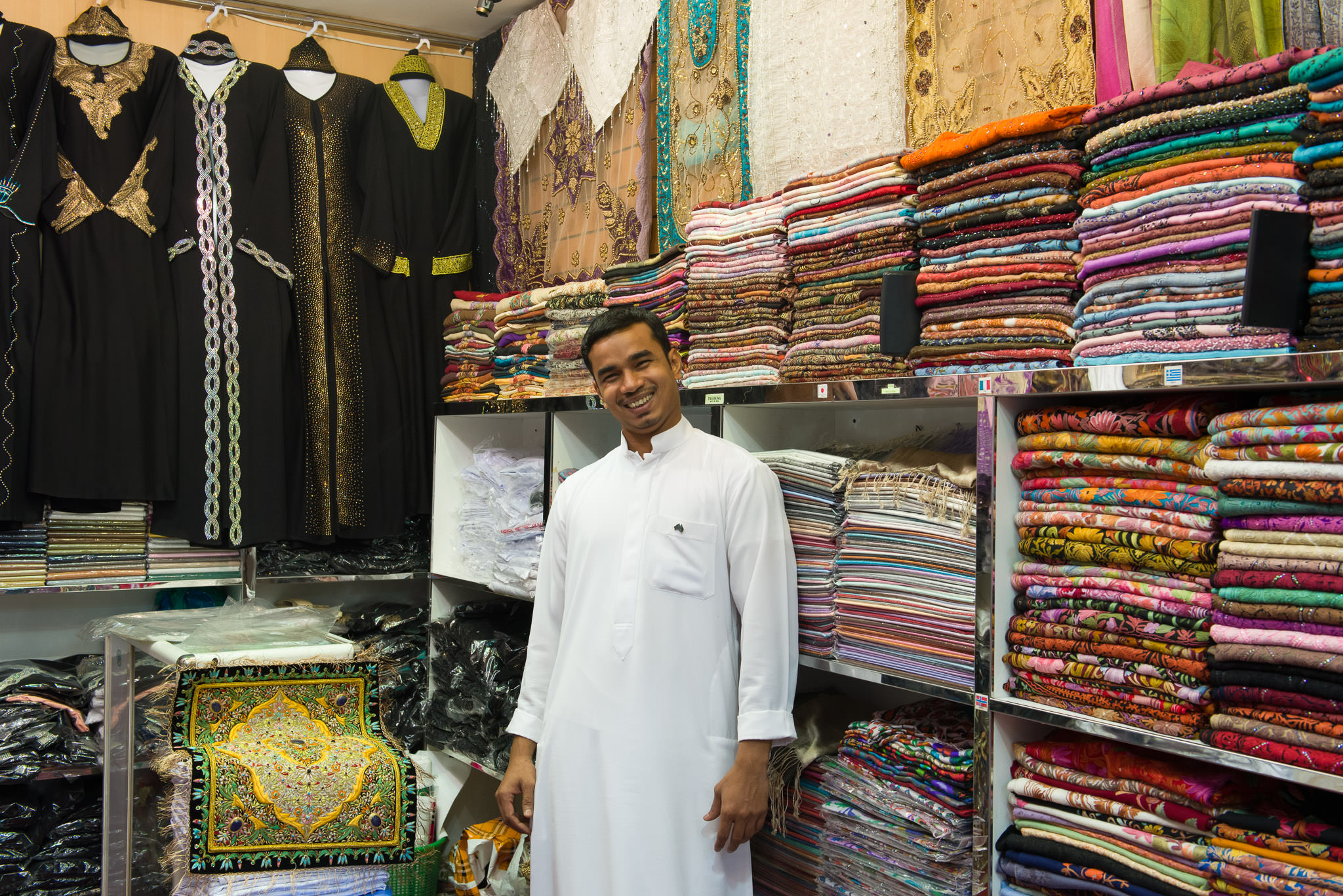
Abdul the shopkeeper. His shop is called “Ali-Saif” and is opposite Popely Jewellery at the Gold Souk, Dubai.
By the time we were finished, Abdul’s shop was a mess, with a serious amount of re-folding and re-stacking to be done. After a little haggling, I happily bought several items, all for Jac. She loved her gifts, by the way, which included pretty table runners with beading and tassels, a beautifully soft blue-black cashmere pashmina, a large woven tablecloth that will double as a couch throw or picnic rug, and an “I love Dubai” T-shirt.
Sheikh Mohammed Centre for Cultural Understanding
The name is a mouthful and frankly, it sounded dull and unappealing to me when I first read about it on our itinerary. But I was surprised – besides being educational, the session was entertaining, eye-opening and delicious.
The SMCCU is a non-profit organisation established in 1998 with His Highness Sheikh Mohammed bin Rashid Al Maktoum as patron. With a motto of “Open Doors. Open Minds”, the SMCCU aims to raise awareness and demystify the local culture, and promote and improve cross-cultural understanding. We visited the SMCCU to take part in one of its unique experiences, a cultural conversation and lunch.
Upon arrival, we were asked to remove our shoes and sit wherever we liked on the cushions arranged in a square around the room.
Our hosts invited us to ask questions and participate in the conversation. Initially, no one spoke up. Our male host broke the ice by going first: “The most popular question I am asked is: ‘What do you have under your dress?’ I tell them, ‘undies, like you!'” We all cracked up.
It was a laidback yet thought-provoking session, with our jovial hosts surprising us, making us roar with laughter, happy to respond to any questions and break down some of the myths about the culture, traditions, values and religion of the people of the UAE. Our hosts acknowledged as with any culture or religion, there will always be people with very traditional and/or conservative views who are often resistant to change; but there are also people who advocate tolerance, acceptance and better understanding of others.
We learned the origins and meaning of some Arabic customs, including the serving of tea and dates to the guests before the main meal – as tea and dates were served to us.
Some of us (OK, maybe just me) were somewhat distracted by the presence of our lunch, all laid out on a rug in front of us in the centre of the courtyard.
There were curries and casseroles, tabbouleh, fish briyani and lamb briyani. Dessert was luqaimat, sweet dough ball dumplings that are deepfried until golden and served with syrup, very popular in Dubai. It was all delicious.
I’ve known for a long time, from my school and university days, that learning makes me hungry! We were free to eat as much as we wanted, and go back for more if we wished.
I was surprised how much fun I had at the cultural lunch. It’s worth doing if you’re interested in learning more about Arabic and Emirati culture and customs. The home-style shared meal was fantastic.
Sheikh Mohammed Centre for Cultural Understanding
House 26, Al Mussallah Road
Bastakiya, Bur Dubai
Telephone: +971 4 353 6666
Open to the public
Sunday to Thursday 8am to 6pm
Saturday 9am to 1pm
Office hours
Sunday to Thursday 9am to 5pm
Saturday 9am to 1pm
Cultural meals
Breakfast every Monday and Wednesday 10am (AED60 per person)
Brunch every Saturday 10.30am (AED80 per person)
Lunch every Sunday and Tuesday 1pm (AED70 per person)
Dinner every Tuesday evening 7pm (AED95 per person)
Other activities, such as mosque visits, walking tour and Emirati dialect language classes are available.
Outside the Centre, a restaurant with a camel cheese burger on the menu (with grilled camel meat, melted cheddar and salad, served with potato wedges, AED43). Sadly, I was full from lunch and knew we had a big dinner planned – squeezing a camel burger in between meals would not be possible.
Back at the hotel late afternoon, I went up on the rooftop deck to enjoy the sweeping views before getting ready for more eating.
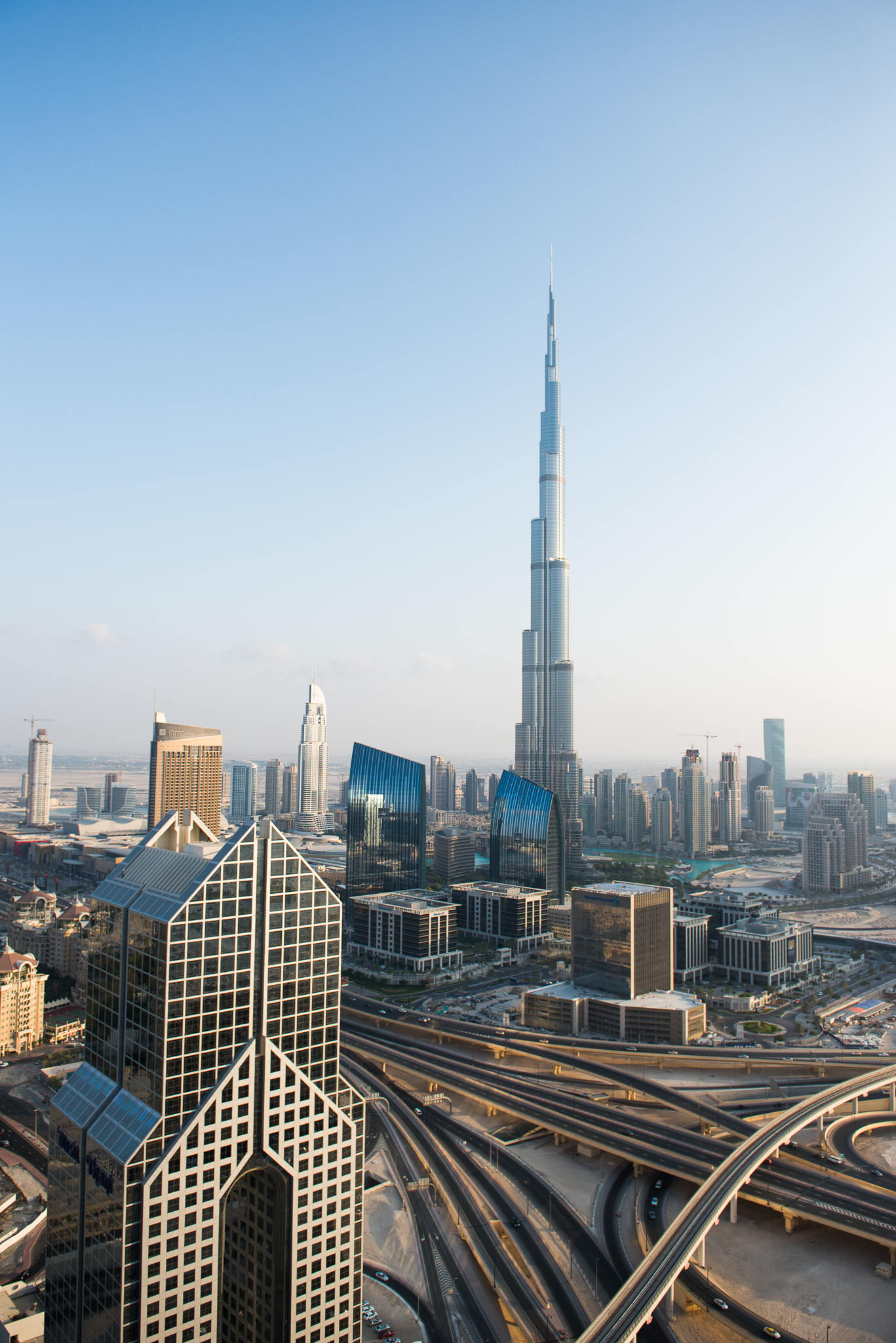
View from the balcony, with Burj Khalifa, the world’s tallest man-made structure, standing at 829.8 m.
That evening, we embarked on a progressive dinner – an eating tour of some of the Shangri-La Hotel Dubai’s restaurants. First stop: entree at Hoi An, the hotel’s award-winning Vietnamese restaurant.
After sipping delightful minty cocktails, we were each presented with a tasting platter of appetisers – a fresh rice paper roll; a juicy housemade grilled duck foie gras sausage wrapped in rice paper leaf, crispy lobster and shiitake ravioli with dried scallop served with fresh apple salad, a moist blue crab cake topped with mayonnaise and micro herbs, tangy pickled vegetable batons, sweet chilli dipping sauce.
Main course was a banquet at the hotel’s Chinese restaurant Shang Palace, which serves traditional Cantonese cuisine and provincial specialties. Our feast included sweet and sour chicken, garlicky juicy prawns with steamed bok choy, stir-fried asparagus, tender black pepper beef, delicate steamed fish fillets and fried rice.
We watched as a tea master spun a bronze kettle with an impossibly thin, long spout. He twirled the kettle around, the picture of concentration, and then poured tea into cups with a flourish, the kettle held high above his head. It was a display of dexterity, flexibility and fearlessness.
For our next course, we went up a level to Amwaj restaurant, Shangri-La Hotel Dubai’s seafood restaurant. But no seafood specialties for us – we were here to sample one of the chef’s dessert creations. Placed before each of us was a dome of metallic appearance that looked more industrial than edible, served with raspberries, praline and nuts. Waiters poured hot chocolate sauce over the each of the domes, and before our eyes, they turned glossy and began to melt, revealing an ice cream core. Our once-mysterious domes were now unmistakably chocolatey, rich and gooey.
Also on the table were plates of macarons and sugar-encrusted blackcurrant jellies. I managed a lemon macaron but was getting quite full by now.
Our last course was tea and sweets at Marrakech, the hotel’s Moroccan restaurant. It was much too dark to take photographs inside but I was happy to relax, drink sugary Moroccan mint tea and munch on a sticky plump date filled with cream cheese and slivered pistachios. But I couldn’t eat another thing that night!
It was past midnight by the time we tumbled into the lift to return to our rooms, full-bellied and content. Thanks so much to our Arabian Adventures driver and guide, and the Shangri-La Hotel team for their wonderful hospitality and a very interesting and enjoyable day.
Shangri-La Hotel Dubai
Sheikh Zayed Road, United Arab Emirates
Telephone: (971 4) 343 8888
Restaurant bookings: (971 4) 405 2703
The Shangri-La Hotel Dubai restaurants we dined in were:
Hoi An – Vietnamese
On Level 1
Open: 7pm to midnight
Shang Palace – Chinese
On Level 1
Lunch 12pm – 3pm
Dinner 7pm – 11.30pm
Amwaj – European, seafood
On Level 2
7pm – 12 midnight
Closed on Saturdays
Marrakech – Moroccan
Level 2
7pm – 12 midnight
Closed on Sundays
TFP travelled to Dubai as a guest of Emirates and the Government of Dubai, Department of Tourism and Commerce Marketing. All images, words and opinions are my own. There’s still more to come in this series (we’re almost at the end). See the list of Dubai posts so far.
